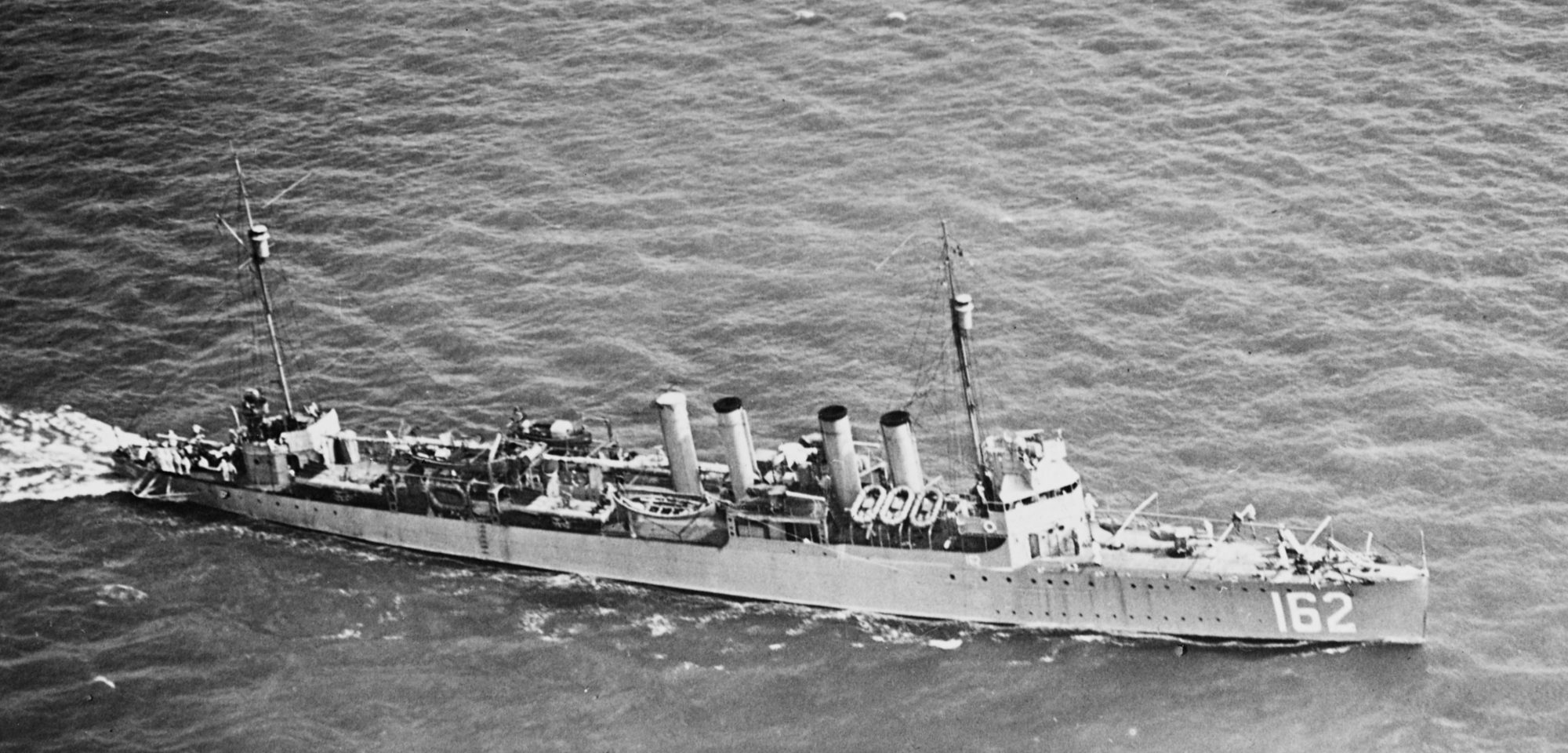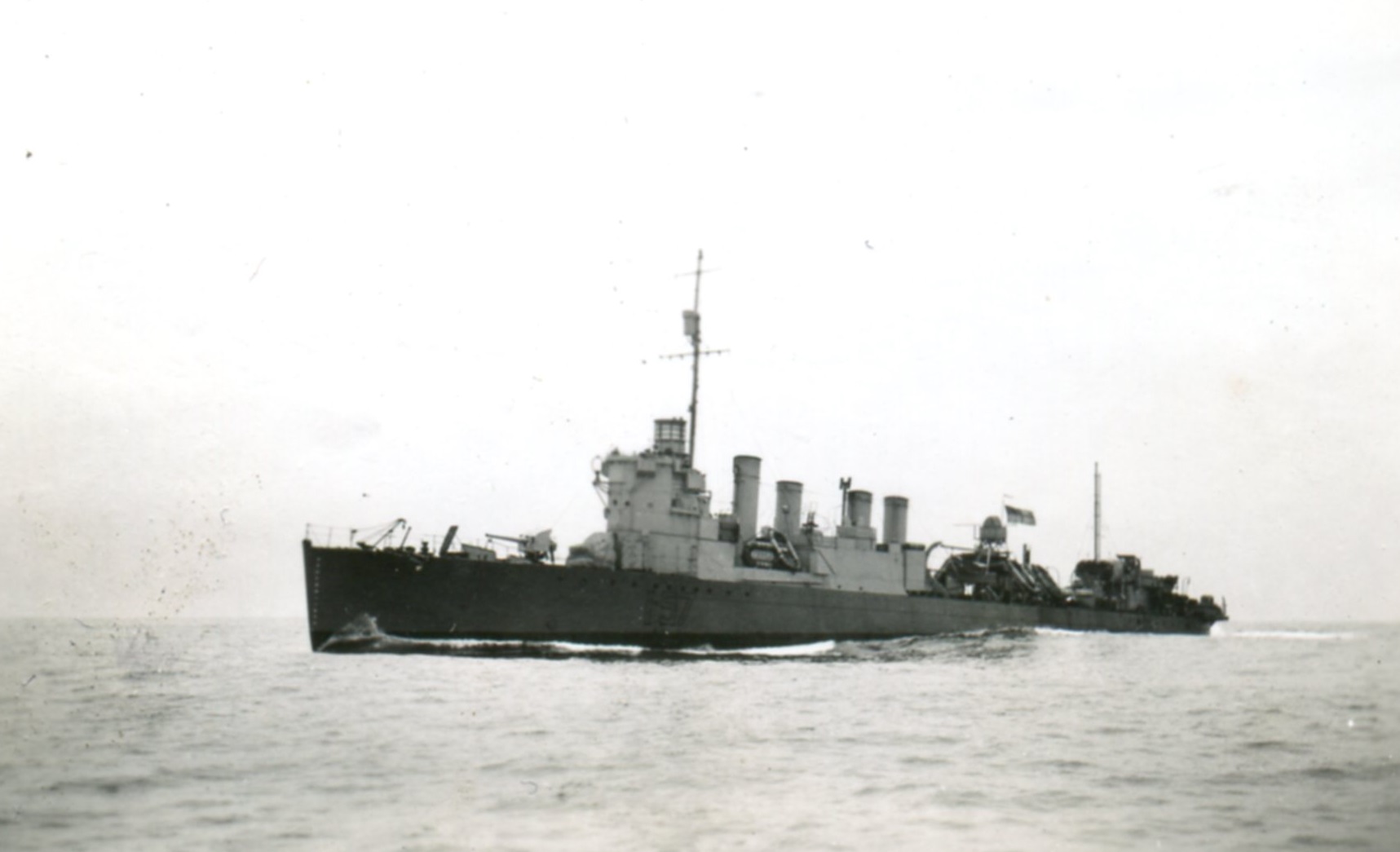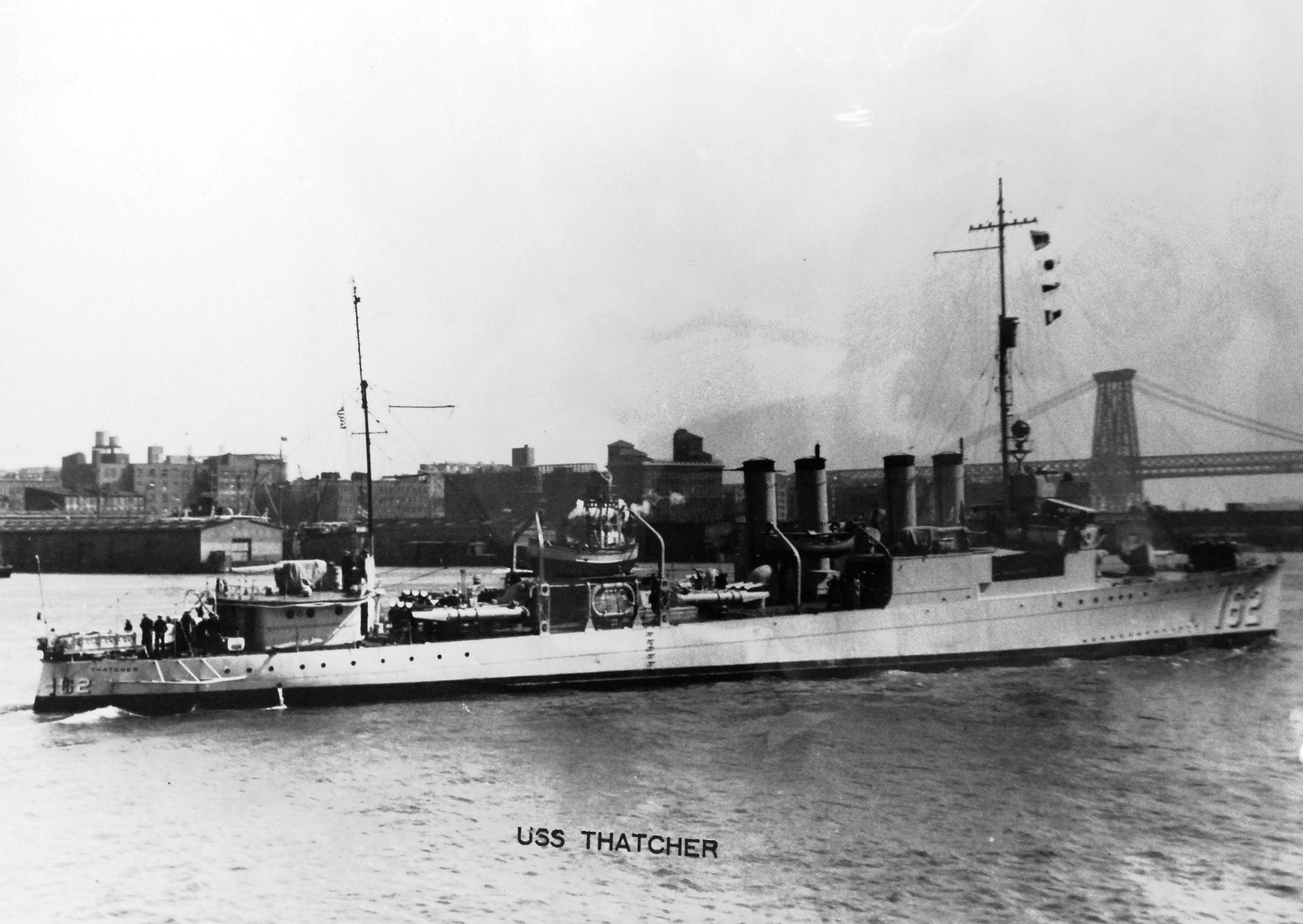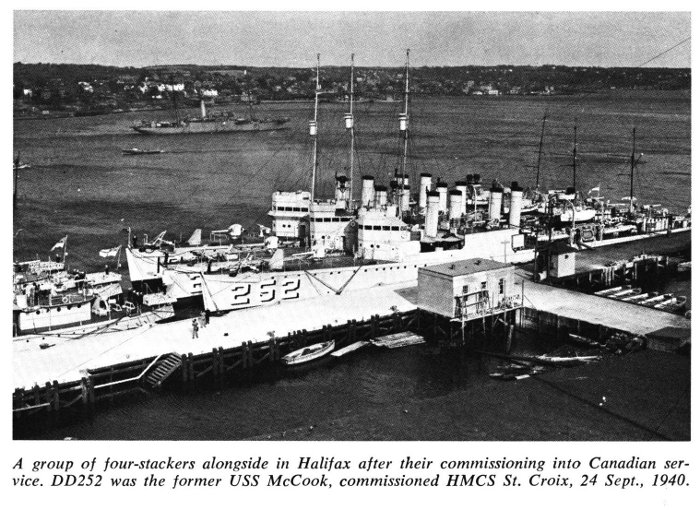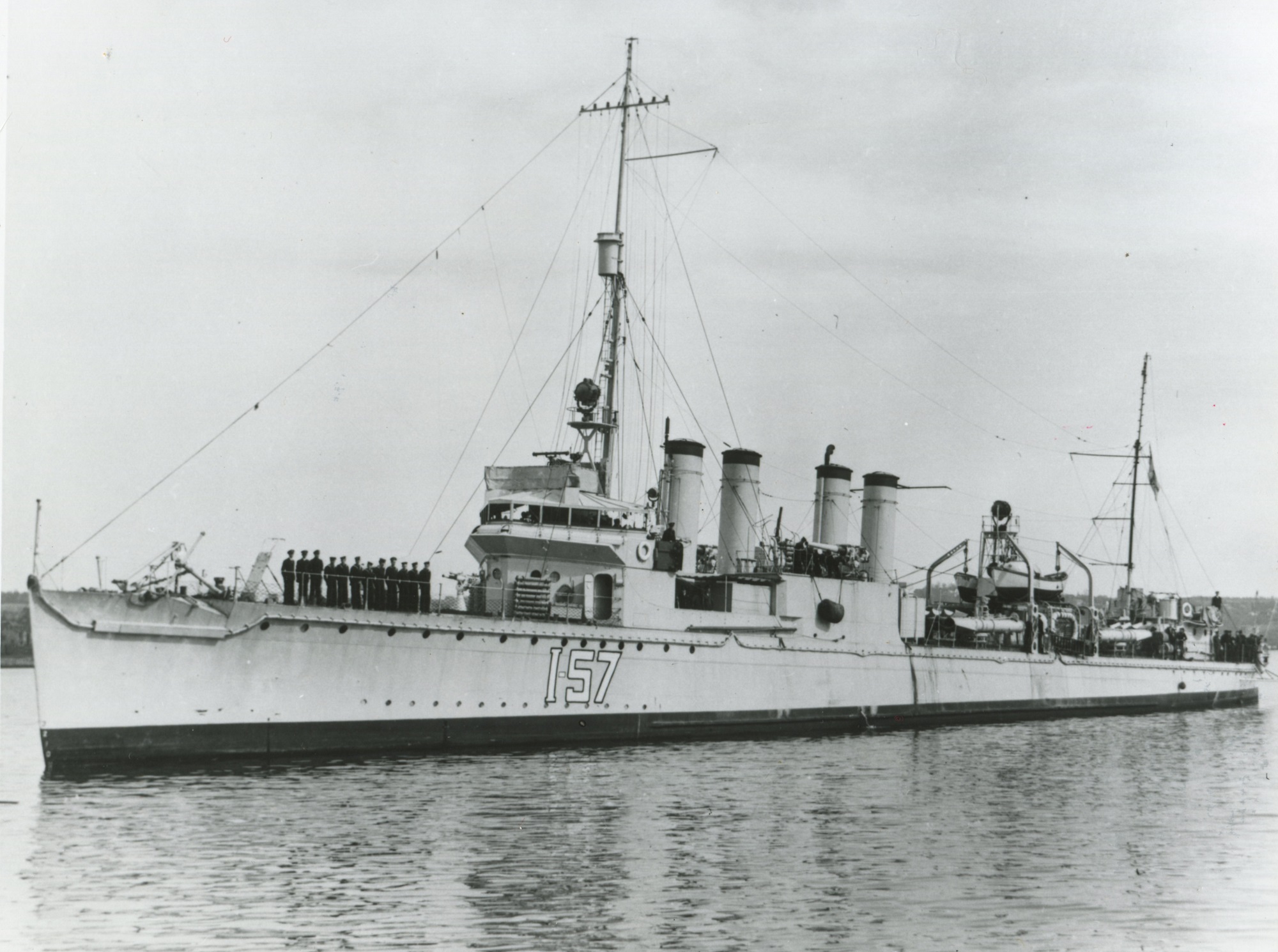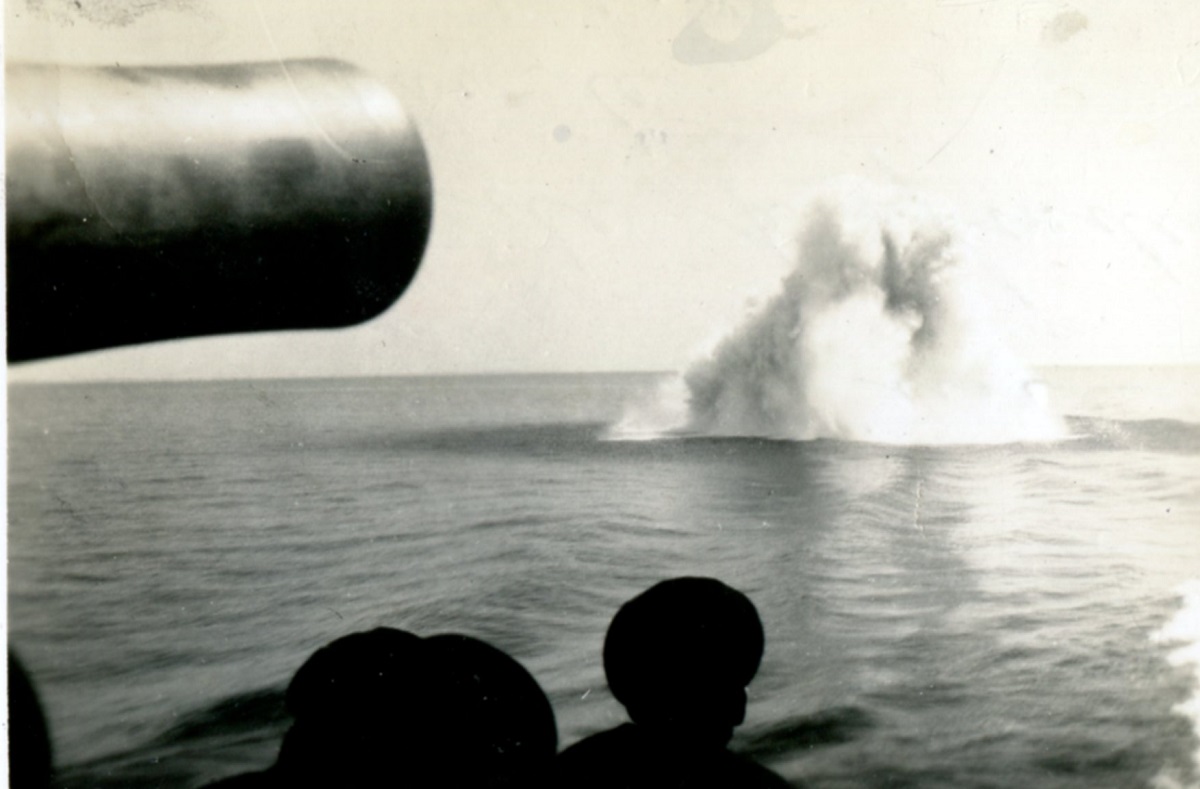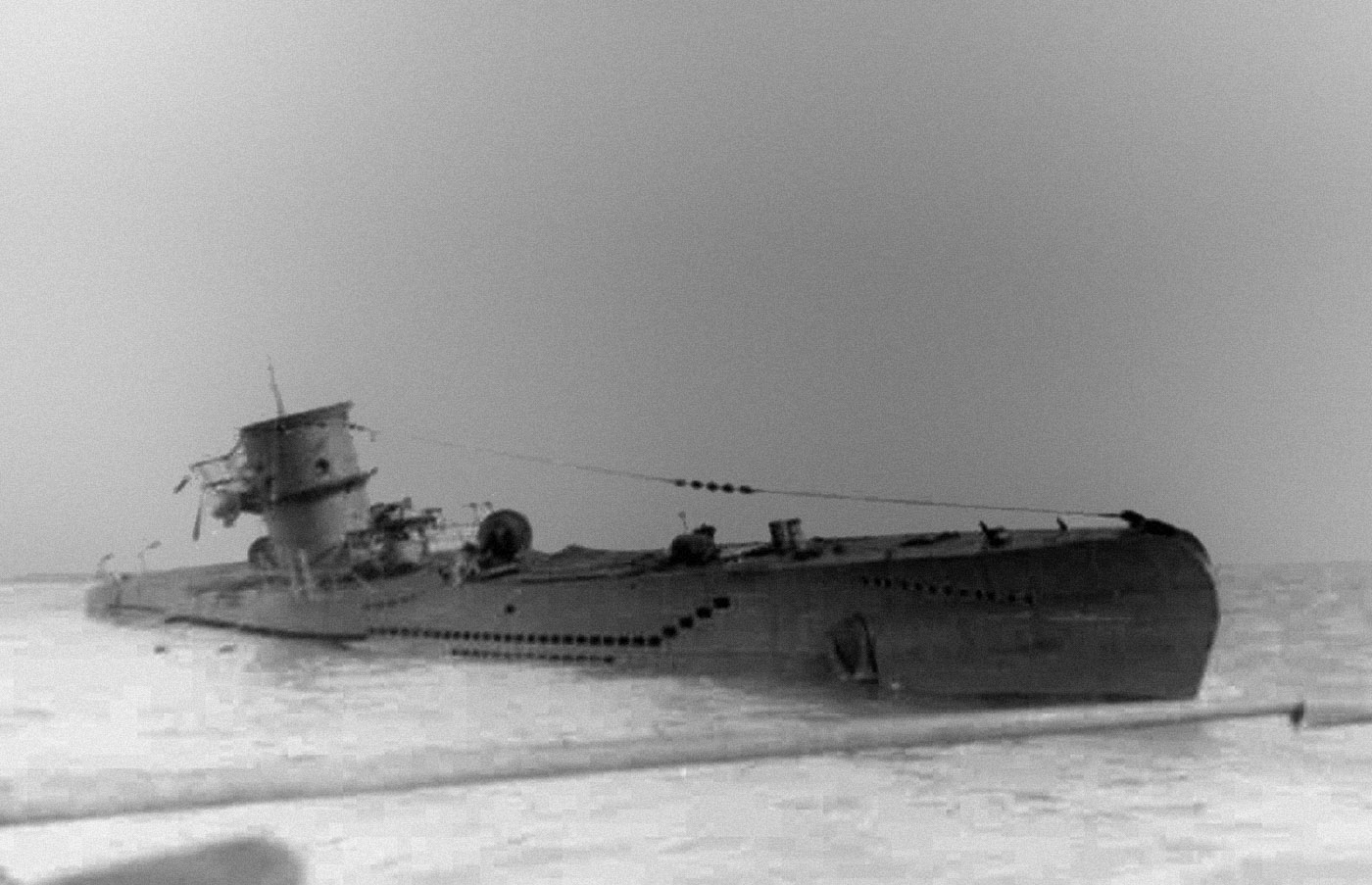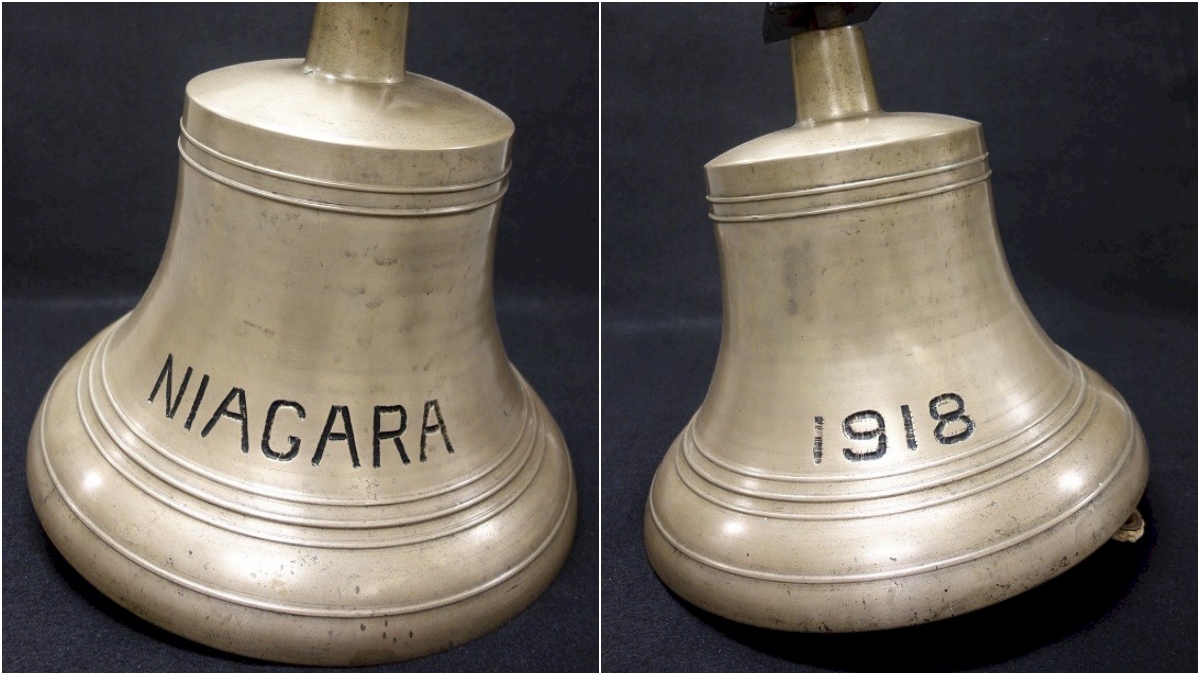Warship Wednesday, Aug. 30, 2023: Weaving the Falls
Here at LSOZI, we take off every Wednesday for a look at the old steam/diesel navies of the 1833-1954 period and will profile a different ship each week. These ships have a life, a tale all their own, which sometimes takes them to the strangest places. – Christopher Eger
Warship Wednesday, Aug. 30, 2023: Weaving the Falls
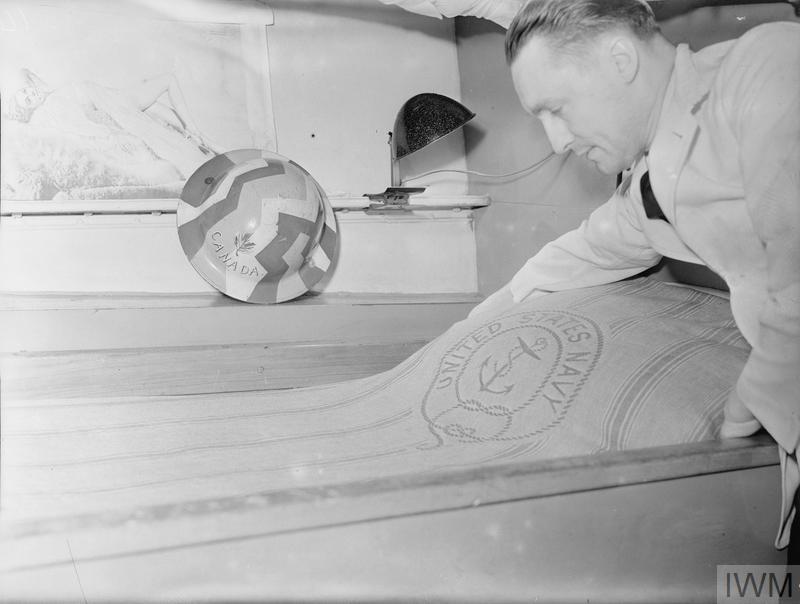
Admiralty Official Collections of the Imperial War Museum, Catalog no. A 3295 by Harold William John Tomlin, a Royal Navy official photographer.
Above we see a circa 1941 image of a Royal Canadian Navy officer aboard the 4th group Town class destroyer HMCS Niagara (I57) making his bunk with a very interestingly camouflaged Mk I “battle bowler” style helmet at the ready. As for the U.S. Navy crest on a bunk cover?
There is a good reason for that, one that goes back 105 years ago this week.
The Wickes
Our ship was one of the iconic first flights of “Four Piper” destroyers that were designed in 1915-16 with input from no less an authority as Captain (later Admiral) W.S. Sims. Beamy ships with a flush deck and a quartet of boilers (with a smokestack for each) were coupled to a pair of Parsons geared turbines to provide 35.3 knots designed speed– which is still considered fast today, more than a century later.
The teeth of these 314-foot, 1,250-ton greyhounds were four 4-inch/50 cal MK 9 guns and a full dozen 21-inch torpedo tubes.
They reportedly had short legs and were very wet, which made long-range operations a problem, but they gave a good account of themselves. Originally a class of 50 was authorized in 1916, but once the U.S. entered WWI in April 1917, this was soon increased and increased again to some 111 ships built by 1920.
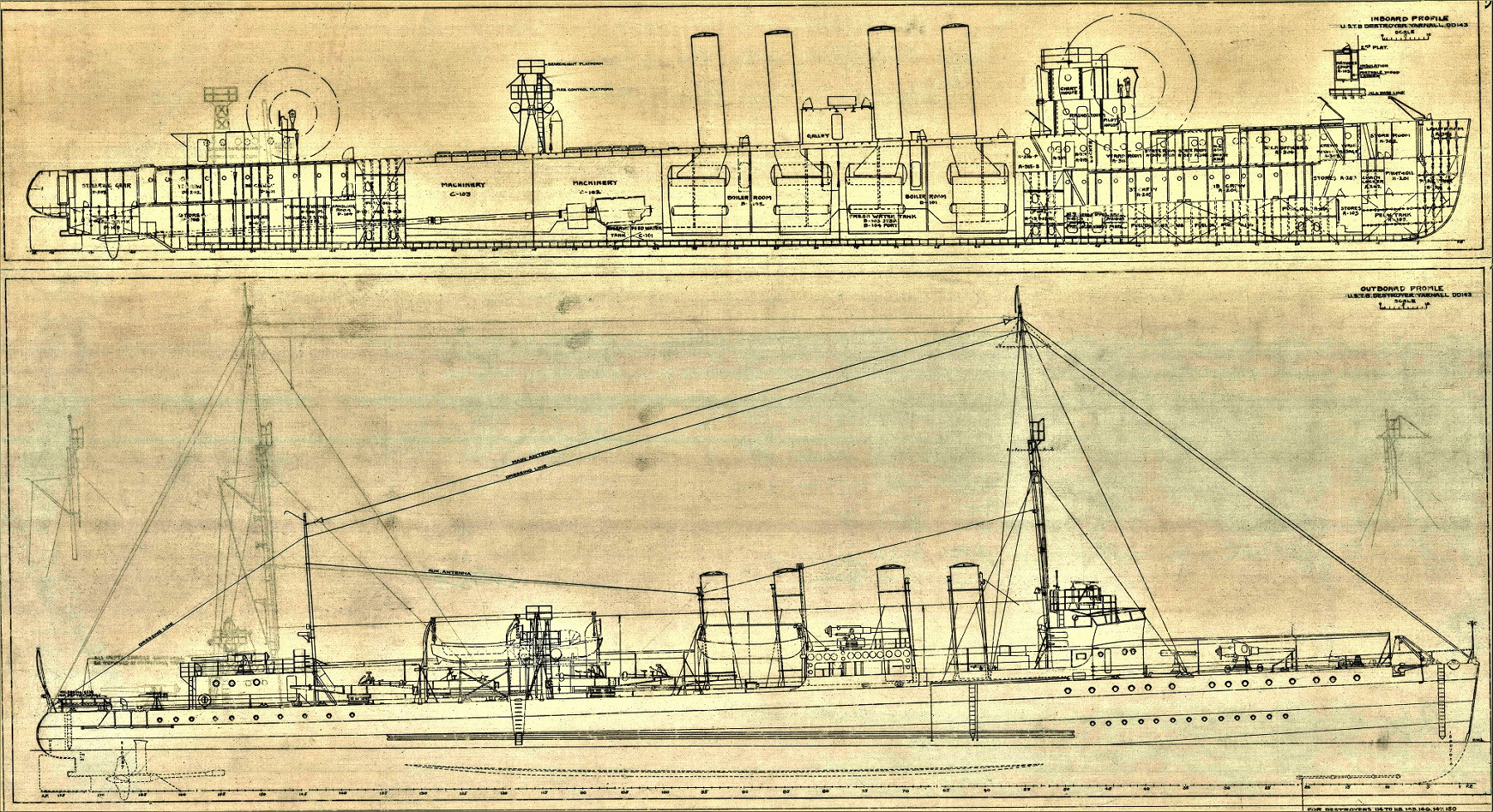
Wickes class USS Yarnall (DD-143): Booklet of General Plans – Inboard Profile / Outboard Profile, June 10, 1918, NARA NAID: 158704871
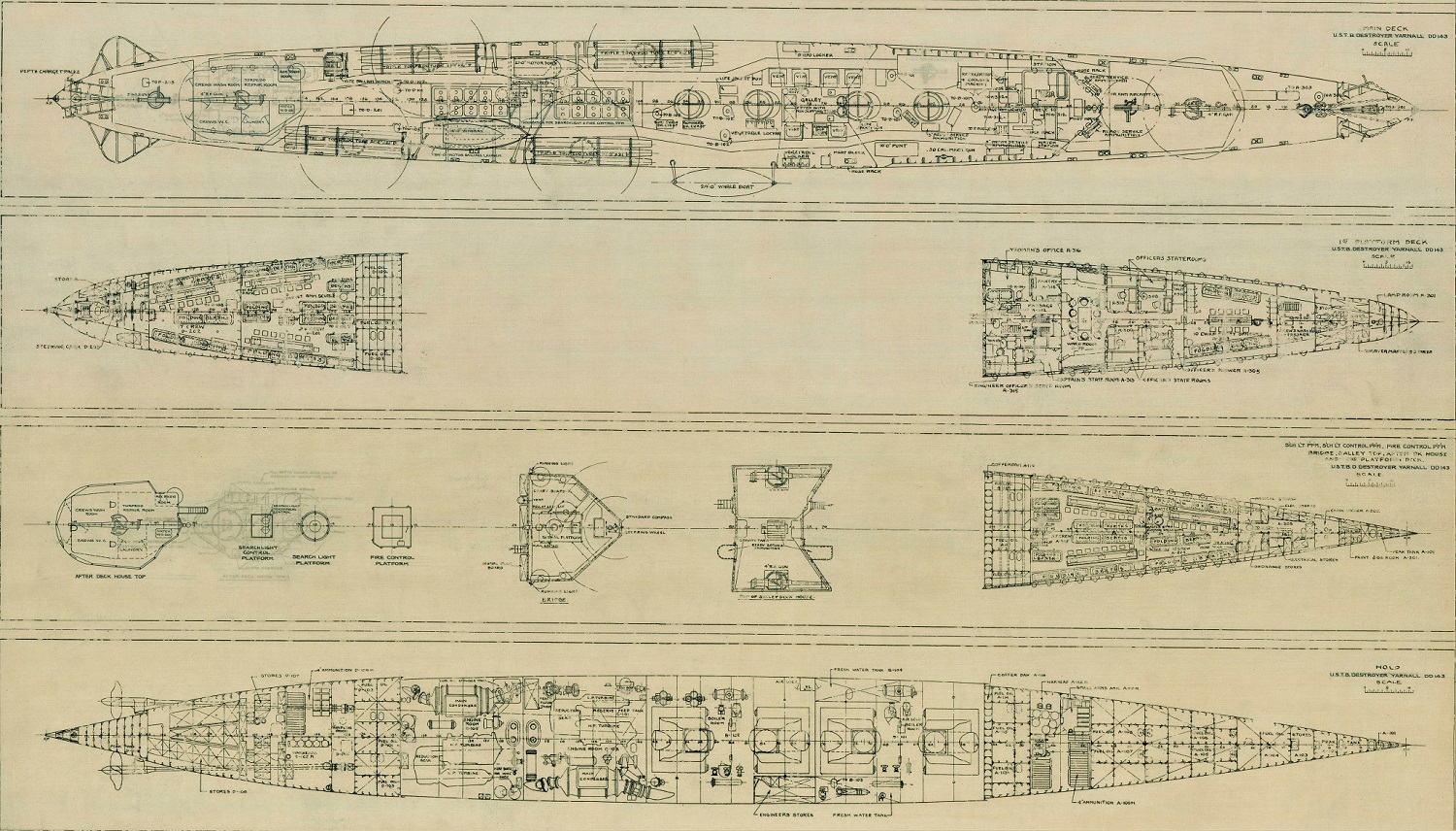
Wickes class USS Yarnall (DD-143): Booklet of General Plans – Main Deck / 1st Platform Deck / S’ch L’t P’f’m, S’ch L’t Control P’f’m, Fire Control P’f’m Bridge, Galley Top, After Dk. House and 2nd Platform Deck. / June 10, 1918, Hold NARA NAID: 158704873

Wickes class. A close-up of her stern top-down view of plans shows the Wickes class’s primary armament– a dozen torpedo tubes in four turnstiles and stern depth charges.
Of the 111 Wickes completed, there were three subclasses besides the 38 standard-design vessels built at Bath Iron Works, Cramp, Mare Island, and Charleston. Then came the 52 Bethlehem-designed ships built at the company’s Fore River (26 ships) and Union Iron Works (26 ships) led by USS Little, the Newport News-built variants (11 ships) starting with USS Lamberton, and New York Shipbuilding-built variants (10 ships) led by USS Tattnall.
The subclasses were constructed to a slightly different set of plans modified by their respective builders, which made for some downright confusing modifications later. In addition, the Bethlehem-designed Little variants tended to have shorter legs and proved unable to cross the Atlantic in a single hop without stopping in the Azores for refueling or completing an underway replenishment.
Anyway…
Meet Thatcher
Our subject was the first warship commissioned to honor RADM Henry Knox Thatcher, USN. Born in 1806, this grandson of Maj. Gen. Henry Knox (George Washington’s artillery master) was first appointed to West Point in 1822 then, after being out sick and resigning, subsequently received an appointment as a midshipman with the Navy the following March at age 16, spending the next four years at sea aboard the frigate USS United States in the Pacific. Then came a string of seagoing assignments as a junior officer in the antebellum period (schooner Porpoise, sloops Erie and Jamestown, frigates Delaware and Brandywine, storeship Relief) before earning his first command, that of the sloop Decatur in 1857.
The Civil War saw him promoted to captain and later commodore, commanding the sloop Constellation in European waters, the screw frigate Colorado with the North Atlantic Blockading Squadron, and a division of Porter’s squadron against Fort Fisher. The war ended with him in command of the Western Gulf Squadron tasked with the reduction of Spanish Fort and Blakeley– the last two holdouts in Mobile Bay– then accepting the surrender of Sabine Pass and Galveston, the last rebel ports.

Promoted to rear admiral in 1866, he held command of the North Pacific Squadron and was placed on the retired list in 1868 after a 45-year career, Thatcher passed in 1880, aged 73.
Appropriately, USS Thatcher (Destroyer No. 162) was laid down on 8 June 1918 by Fore River at Quincy, Massachusetts; launched 105 years ago this week on 31 August 1918 sponsored by Miss Doris Bentley, the grandniece of RADM Thatcher; and, too late for the Great War, was commissioned on 14 January 1919, with LCDR Francis Warren Rockwell (USNA 1908)– a Navy Cross holder for his time on the destroyer USS Winslow (DD-53) during WWI and future VADM who later commanded the 16th Naval District in the Philippines at the outbreak of World War II in the Pacific— as her first seagoing skipper.
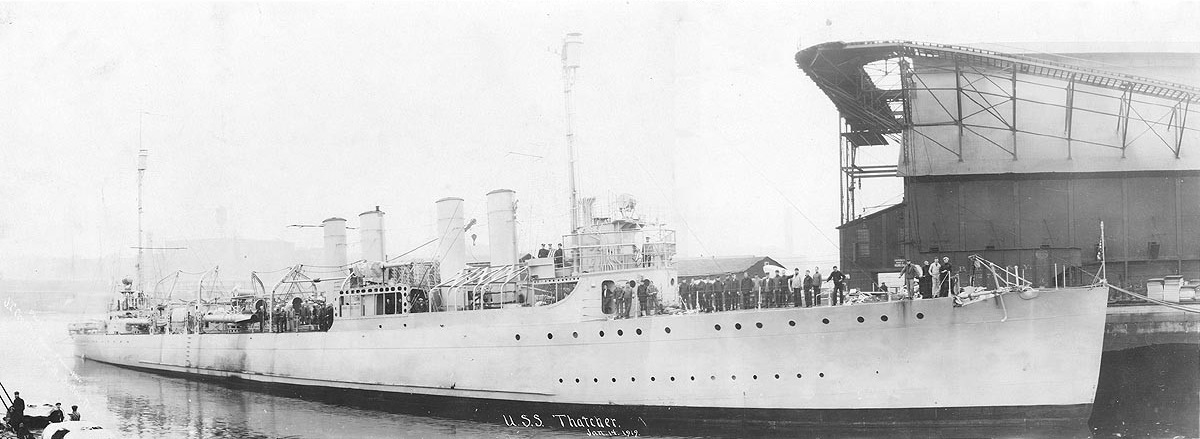
USS Thatcher (Destroyer # 162) At the Boston Navy Yard, Massachusetts, 14 January 1919. Panoramic photograph by J. Crosby, Naval Photographer, # 11 Portland Street, Boston. NH 99264
In all, USS Thatcher’s construction only lasted just 220 days, a wonder of wartime shipbuilding.
Her active-duty U.S. Naval career was correspondingly short, spanning just 40 months but she was part of the support group for the pioneering NC-4 flying boat crossing of the Atlantic in May 1919.
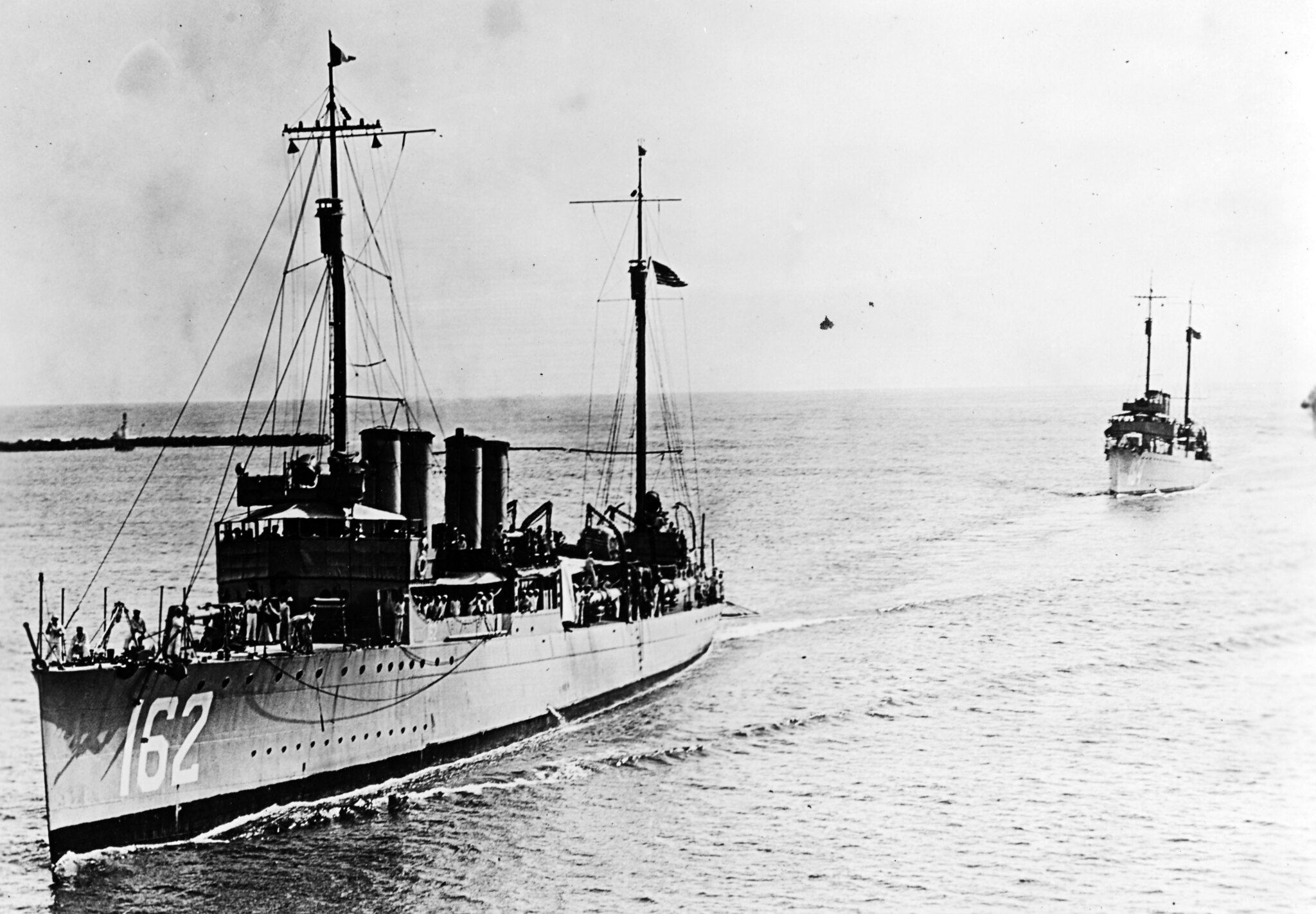
USS Thatcher (DD-162). Leading other destroyers into a harbor, circa 1919-1921. The next ship astern is USS Crosby (DD-164). This was likely during the NC flying boat crossing as Thatcher operated on picket station number 9, one of 21 stations strung out from Newfoundland and Labrador to the Azores, between her sister ships Walker (Destroyer No. 163) and Crosby. Underway at sea, she provided visual and radio bearings for the flying boats as they passed overhead on their way toward Lisbon, Portugal. NH 41952
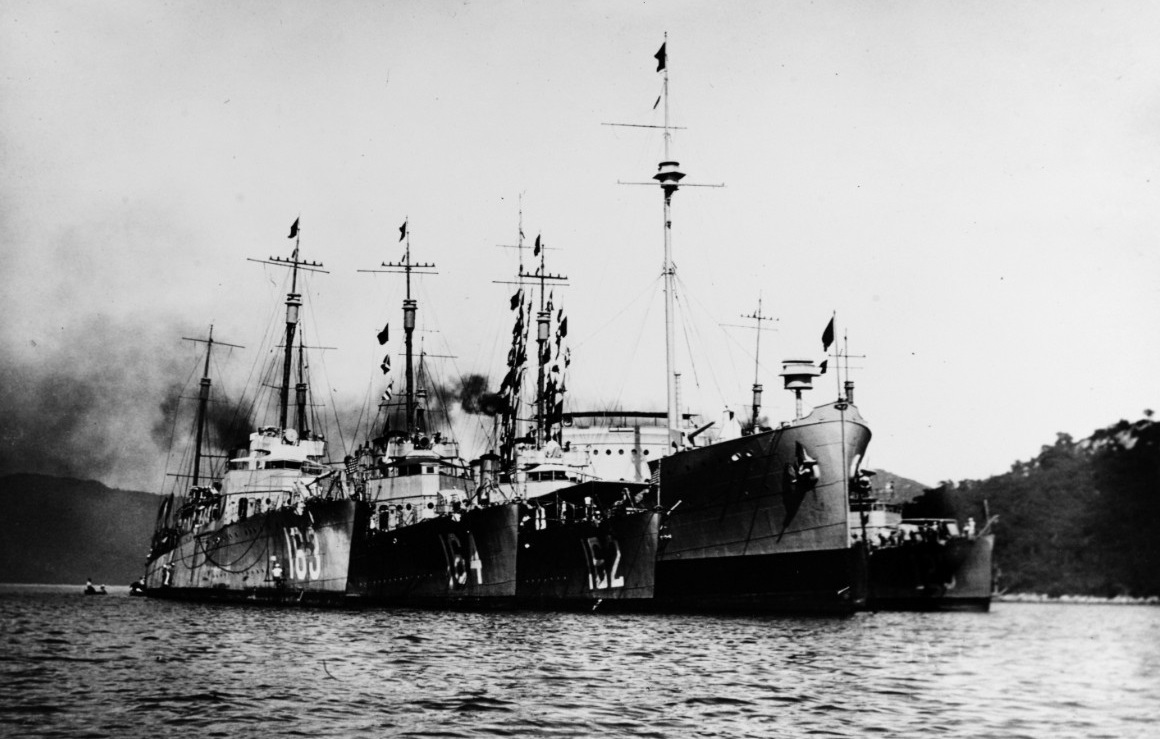
USS Cuyama (Oiler # 3) at Acapulco, Mexico, circa 1919, with several destroyers alongside. Destroyers off Cuyama’s starboard side are (from left to center: USS Walker (Destroyer # 163); USS Crosby (Destroyer # 164); and USS Thatcher (Destroyer # 162). USS Gamble (Destroyer # 123) is moored along Cuyama’s port side. Courtesy of Donald M. McPherson, 1976. NH 85033
Transferred to the Pacific in the autumn of 1921, Thatcher operated out of San Diego, conducting exercises and training cruises off the West Coast with reduced manning (her last three skippers were ensigns and LTJGs) until decommissioned there on 7 June 1922.
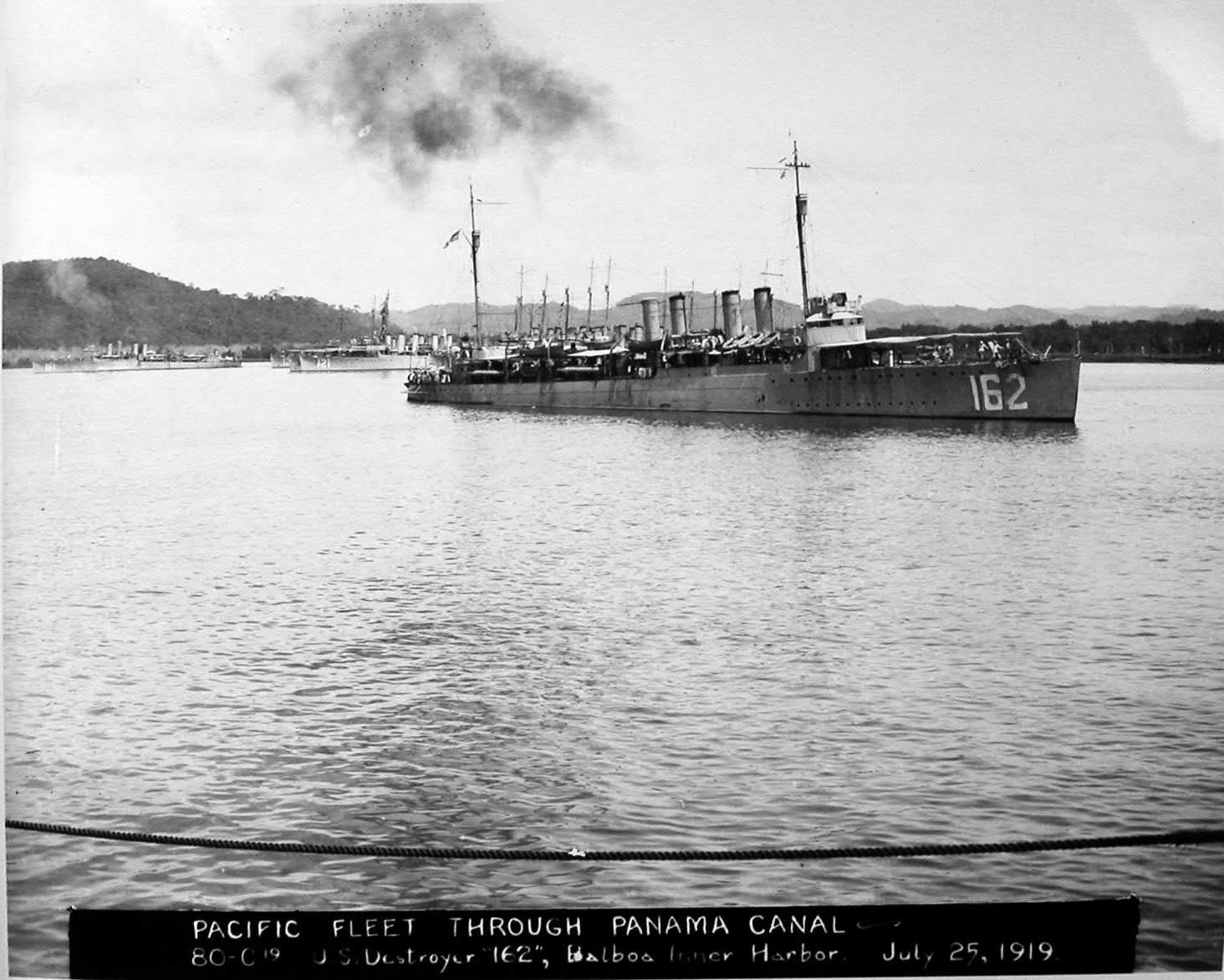
Pacific Fleet Through Panama Canal US Destroyer “162”, Balboa Inner Harbor July 25, 1919. National Archives Identifier 100996438
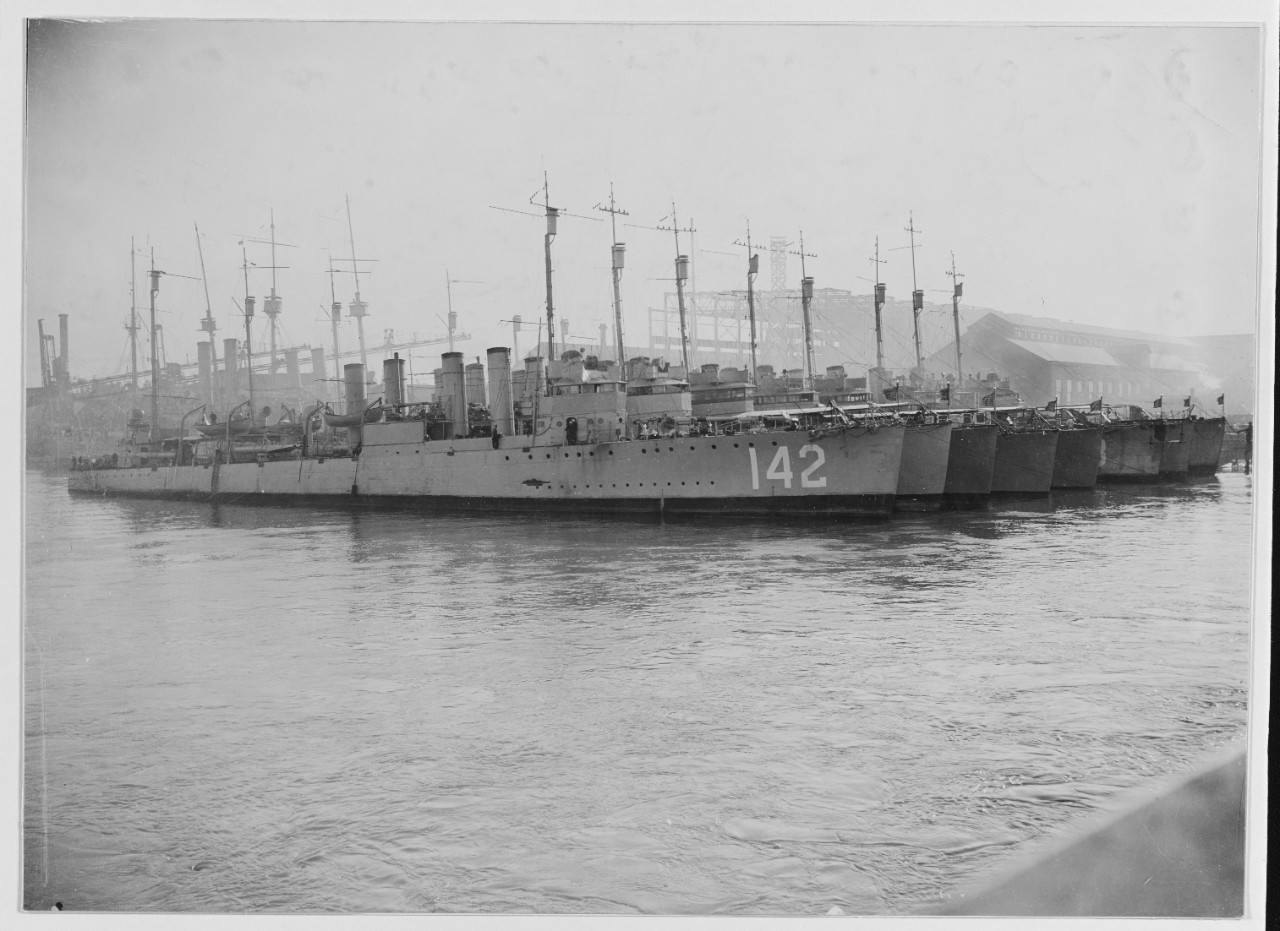
Destroyers at the Mare Island Navy Yard, 1919 (from left to right): USS Tarbell (Destroyer # 142); USS Thatcher (Destroyer # 162); USS Rizal (Destroyer # 174); USS Hart (Destroyer # 110); USS Hogan (Destroyer # 178); USS Gamble (Destroyer # 123); USS Ramsay (Destroyer # 124); and USS Williams (Destroyer # 108). Donation of Rear Admiral Ammen Farenholt, NH 42537
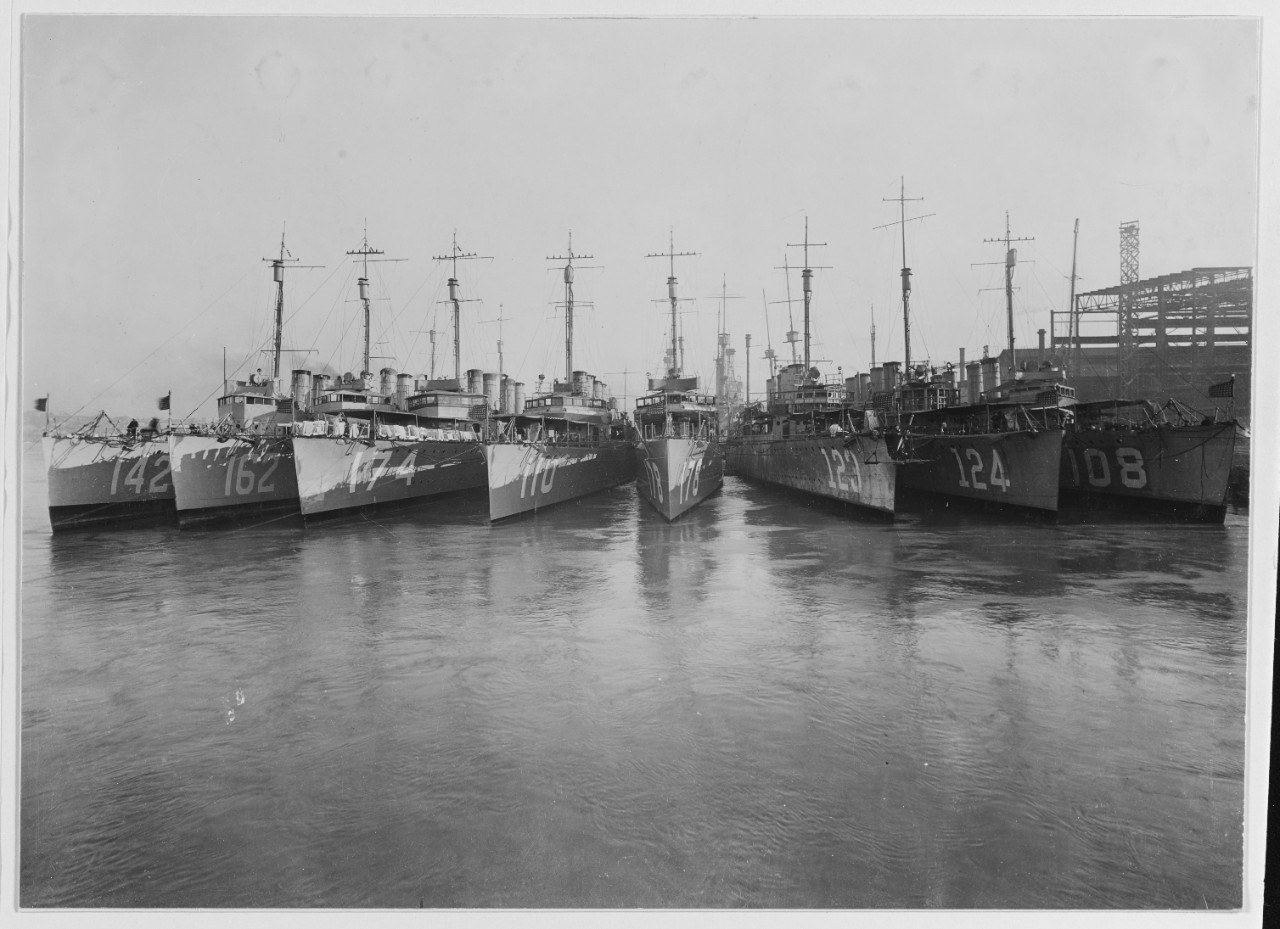
Destroyers at the Mare Island Navy Yard, 1919, L to R: USS Tarbell (Destroyer # 142); USS Thatcher (Destroyer # 162); USS Rizal (Destroyer # 174); USS Hart (Destroyer # 110); USS Hogan (Destroyer # 178); USS Gamble (Destroyer # 123); USS Ramsay (Destroyer # 124); and USS Williams (Destroyer # 108). Donation of Rear Admiral Ammen Farenholt. NH 42538
She would sway quietly along with others of her kind in the California mothball fleet for another 17 years.
Brought back to life
With war coming again to Europe, Thatcher was recommissioned at San Diego on 18 December 1939, then transferred to the Atlantic the following spring after shakedowns and workups.
Transiting the Panama Canal on 1 April 1940, just before the German blitzkrieg against France and the Low Countries, Thatcher conducted Neutrality Patrols and training cruises off the east coast and in the Gulf of Mexico through the summer of 1940.
Headed to serve the King
With Europe again at war, on 2 September 1940, FDR signed the so-called Destroyers for Bases Agreement that saw a mix of 50 (mostly mothballed) Caldwell (3), Wickes (27), and Clemson (20)-class destroyers transferred to the Royal Navy in exchange for limited basing rights on nine British overseas possessions. Canada would receive seven of these ships including five Wickes, doubling the number of destroyers in the Canadian Navy in days.
In respect of Canada’s naming tradition for destroyers, all seven RCN flush deckers were named for Canadian rivers, ideally, those that ran in conjunction with the U.S. border, a nice touch. Thatcher, therefore, became HCMS Niagra, so named after the river that becomes the Falls in New York.
Sailed by scratch USN crews from Philadelphia, Thatcher and five of her sisters arrived at Halifax, Nova Scotia, on 20 September 1940, the third group of the “flush deckers” transferred.
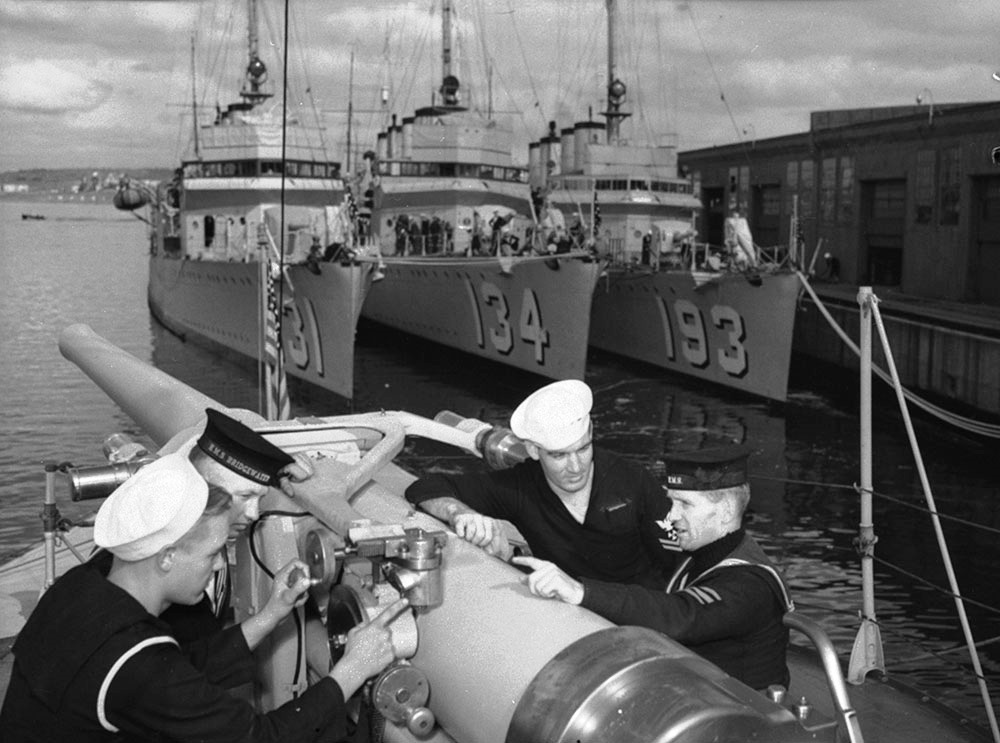
Transfer of U.S. destroyers to the Royal Navy in Halifax, Sept 1940. Wickes-class destroyers USS Buchanan (DD-131), USS Crowninshield (DD-134), and USS Abel P. Upshur (DD-193) are in the background. The sailors are examining a 4-inch /50 cal deck gun. Twenty-three Wickes-class destroyers were transferred to the RN, along with four to the RCN, in 1940 under the Destroyers for Bases Agreement. (Library and Archives Canada Photo, MIKAN No. 3199286)
Decommissioned from the U.S. Navy on 24 September 1940, Thatcher was renamed HMCS Niagara (I57) and, headed for a refit for RN service by HM Dockyard Devonport, departed Halifax on 30 November; proceeded eastward via St. John’s, Newfoundland where she joined Convoy HX 080 as an escort on 10 December.
She wasn’t struck from the U.S. Navy List until 8 January 1941.
Besides HX 080, she would ride shotgun with no less than 13 Atlantic convoys in 1941 as part of the Newfoundland Escort Force (NEF), 17 in 1942, 16 in 1943, and one in 1944 for a total of 48 wartime convoy runs.
During this service, she was often a lifesaver, for instance escorting the battered Danish merchantman Triton into Belfast in January 1942, rescuing the survivors of the American merchantman SS Independence Hall two months later, then picking up 12 shaken survivors from the sunken steamer SS Rio Blanco, which had been torpedoed by U-160 in April; followed by 8 survivors from the Norwegian tanker Kollskegg that sent to the bottom by U-754.
Harold William John Tomlin, a Royal Navy official photographer, took a series of detailed shots of the (reserve) officers and crew of HMCS Niagara in action, likely in 1941, and they are preserved in the collections of the Imperial War Museum.
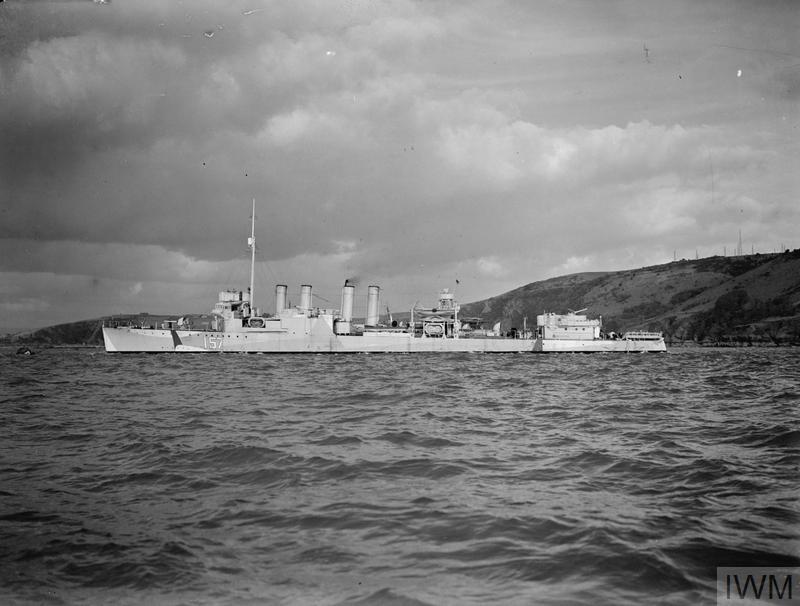
HMCS NIAGARA, TOWN CLASS DESTROYER, ONE OF THE FIFTY DESTROYERS HANDED OVER BY THE UNITED STATES OF AMERICA IN EXCHANGE FOR THE USE OF THE BASES. 1941, ON BOARD THE DESTROYER, SHE HAS AN ENTIRELY CANADIAN CREW, SOME OF WHOM ARE EXPERIENCING THEIR FIRST TASTE OF NAVAL LIFE. AMONGST THEM ARE LUMBERJACKS, FARMERS, WAREHOUSEMEN, ETC., WHO UNTIL THEY BROUGHT THE NIAGARA ACROSS THE ATLANTIC HAD NEVER BEEN TO SEA. TYPES OF CANADIANS FORMING THE CREW OF HMCS NIAGARA SOME WEARING THEIR UNUSUAL HEADGEAR, ETC. (A 3289) HMCS NIAGARA. Copyright: © IWM. Original Source: http://www.iwm.org.uk/collections/item/object/205137695
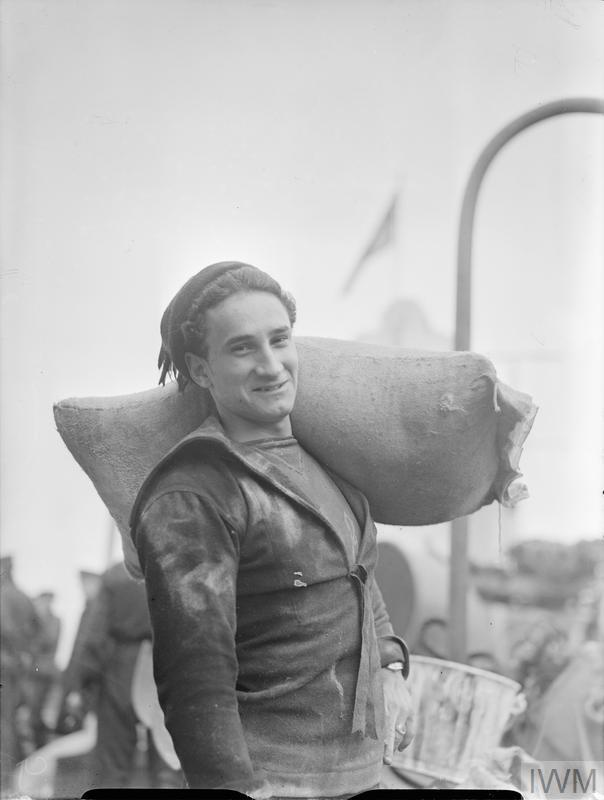
THE ROYAL CANADIAN NAVY DURING THE SECOND WORLD WAR (A 3277) Jack Farrell, a sailor in the Royal Canadian Navy, walks across the deck carrying a sack over his left shoulder aboard HMCS NIAGARA an ex-American Town class destroyer, 1941. Copyright: © IWM. Original Source: http://www.iwm.org.uk/collections/item/object/205119367
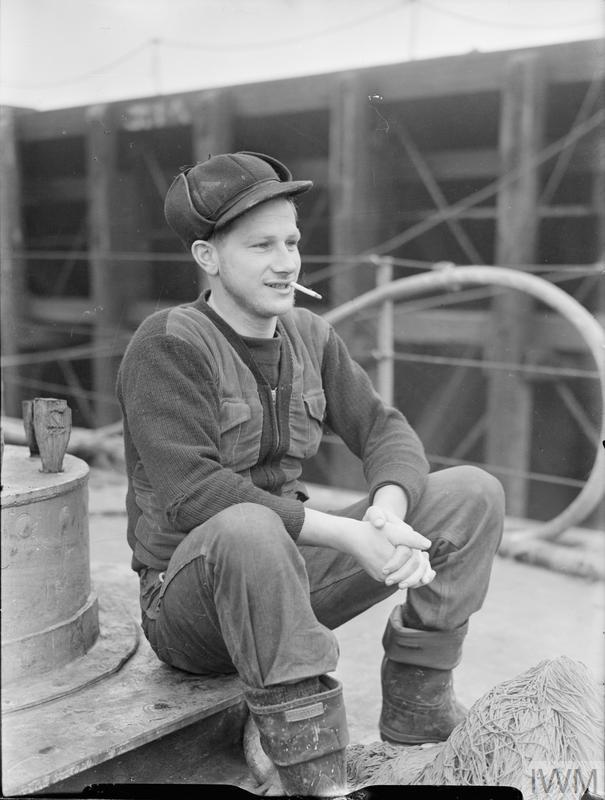
THE ROYAL CANADIAN NAVY DURING THE SECOND WORLD WAR (A 3273) Gerald Moore, a sailor in the Royal Canadian Navy, smokes a cigarette whilst sitting on the deck of HMCS NIAGARA an ex-American Town class destroyer, 1941. He is wearing a peaked hat with tied-up ear covers commonly worn by Canadian servicemen. Copyright: © IWM. Original Source: http://www.iwm.org.uk/collections/item/object/205119365
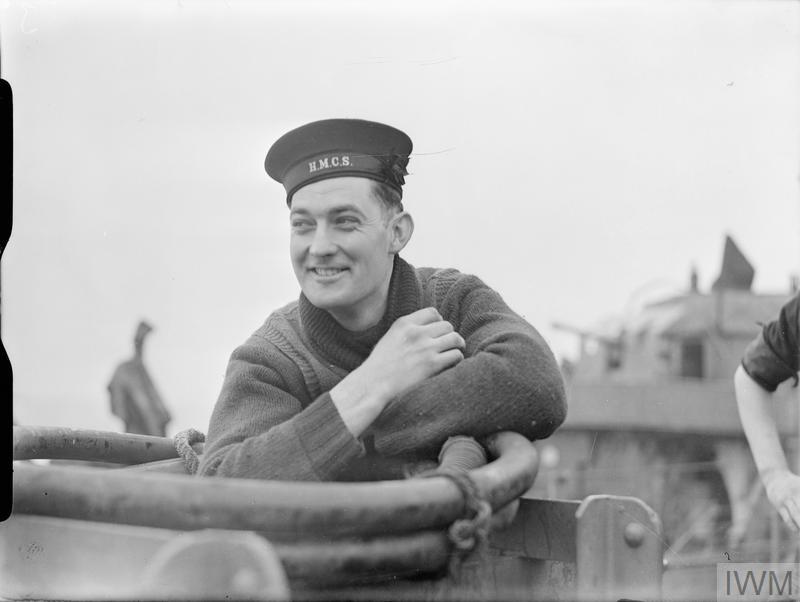
THE ROYAL CANADIAN NAVY DURING THE SECOND WORLD WAR (A 3275) Ski Doyle, a sailor in the Royal Canadian Navy, leans against the railings of HMCS NIAGARA an ex-American Town class destroyer, 1941. Rather than the standard bib, Doyle is dressed in a woolen roll-necked jumper. Copyright: © IWM. Original Source: http://www.iwm.org.uk/collections/item/object/205119366
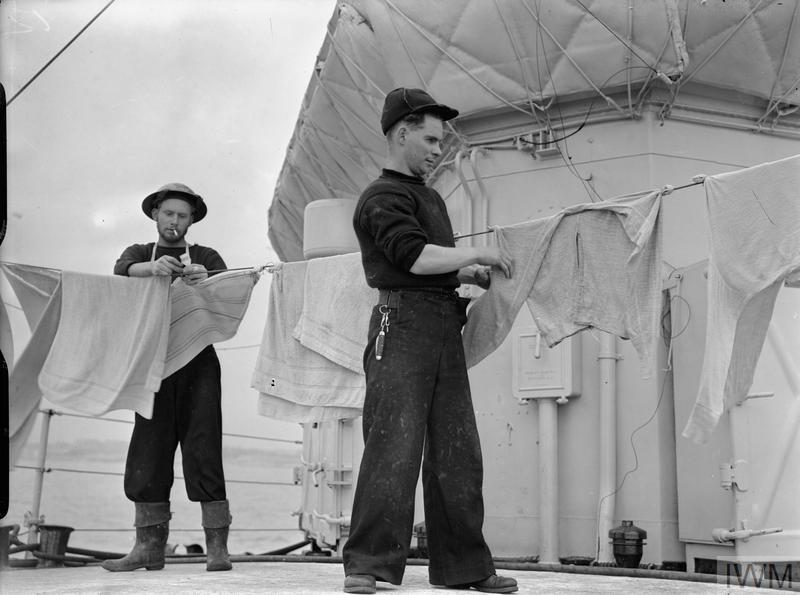
THE ROYAL NAVY DURING THE SECOND WORLD WAR (A 3293) Two Canadian sailors from HMCS NIAGARA hand washing from improvised lines strung across the deck of their ship. Copyright: © IWM. Original Source: http://www.iwm.org.uk/collections/item/object/205185254
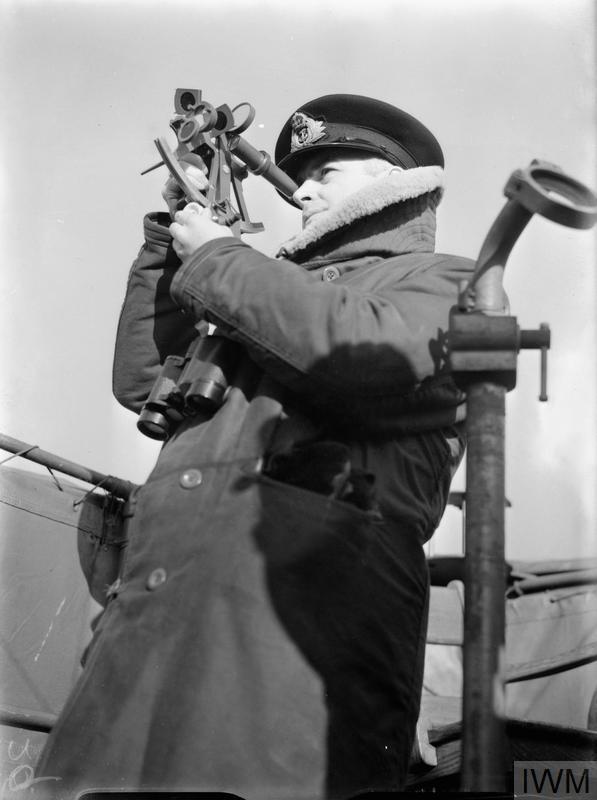
THE ROYAL NAVY DURING THE SECOND WORLD WAR (A 3284) The Navigating Officer of HMCS NIAGARA uses a sextant to get a bearing at sea. He is wearing a heavy coat to protect him from the cold of the open bridge. Copyright: © IWM. Original Source: http://www.iwm.org.uk/collections/item/object/205185253

THE ROYAL NAVY DURING THE SECOND WORLD WAR (A 3297) The Blue watch has a sing-song on board HMCS NIAGARA, a Town class destroyer. An accordion, guitar, and mandolin are being played by some of the sailors. Copyright: © IWM. Original Source: http://www.iwm.org.uk/collections/item/object/205185255
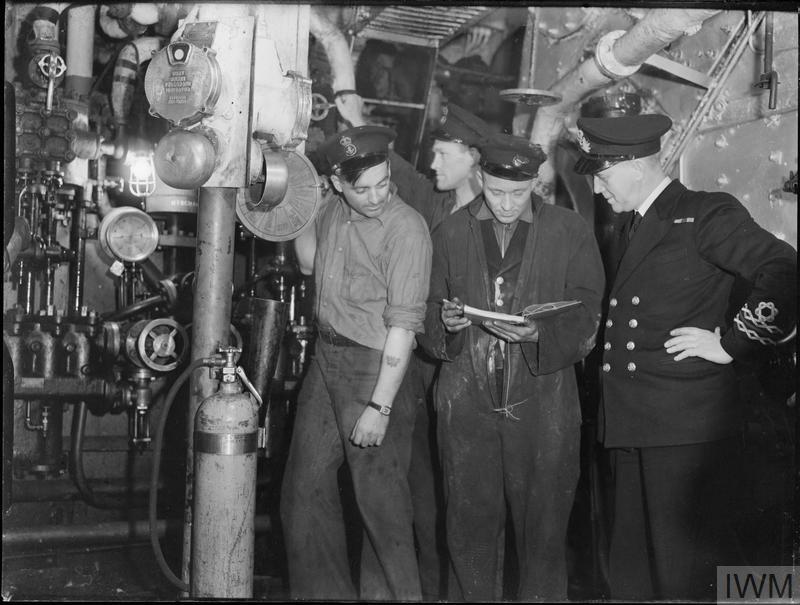
THE ROYAL NAVY DURING THE SECOND WORLD WAR (A 3299) The Engineer Officer of HMCS NIAGARA carries out an inspection of the boiler room to make sure that all is ready for sea. Copyright: © IWM. Original Source: http://www.iwm.org.uk/collections/item/object/205185256
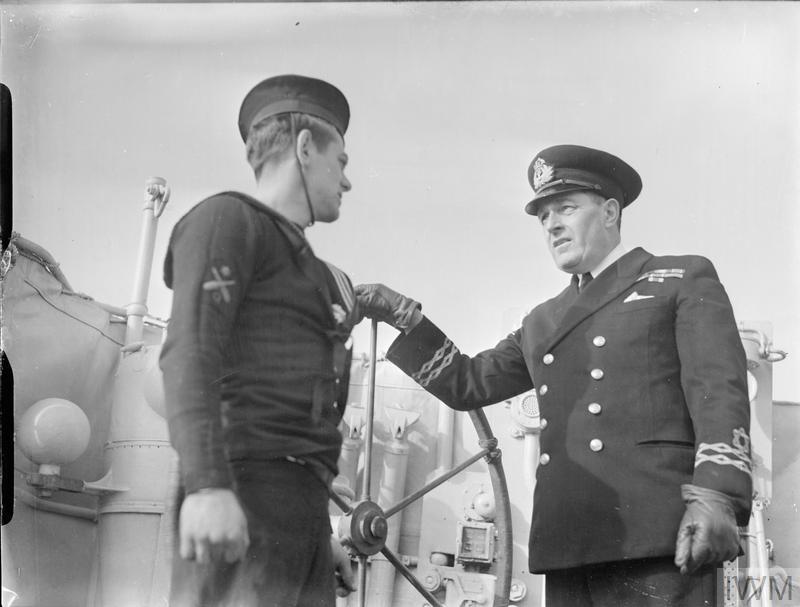
HMCS NIAGARA, The First Lieutenant, a veteran of the last war makes the rounds of the ship. Copyright: © IWM. Original Source: http://www.iwm.org.uk/collections/item/object/205137709
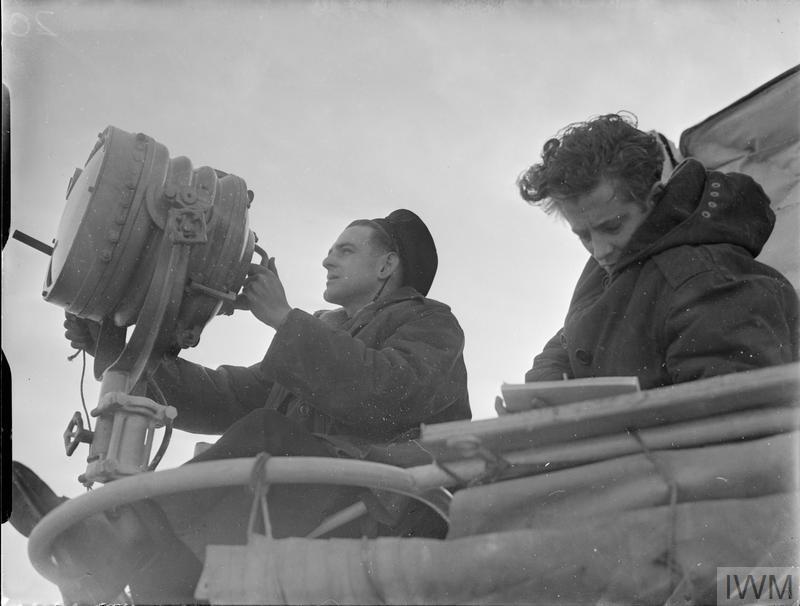
HMCS NIAGARA, Up on the signal deck, Signalmen receive a signal instructing the Commanding Officer to take his ship to sea. Copyright: © IWM. Original Source: http://www.iwm.org.uk/collections/item/object/205137704
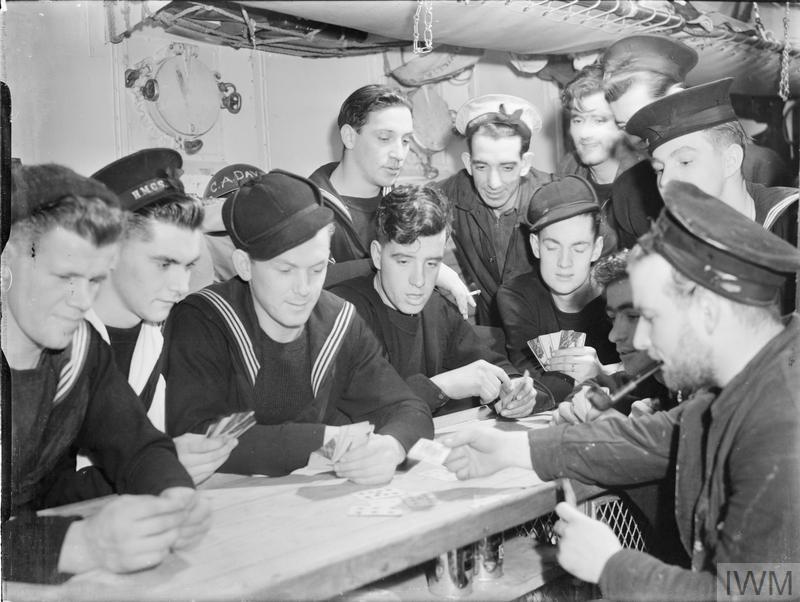
HMCS NIAGARA, Down on the mess deck members of the Red Watch play cards. Copyright: © IWM. Original Source: http://www.iwm.org.uk/collections/item/object/205137701
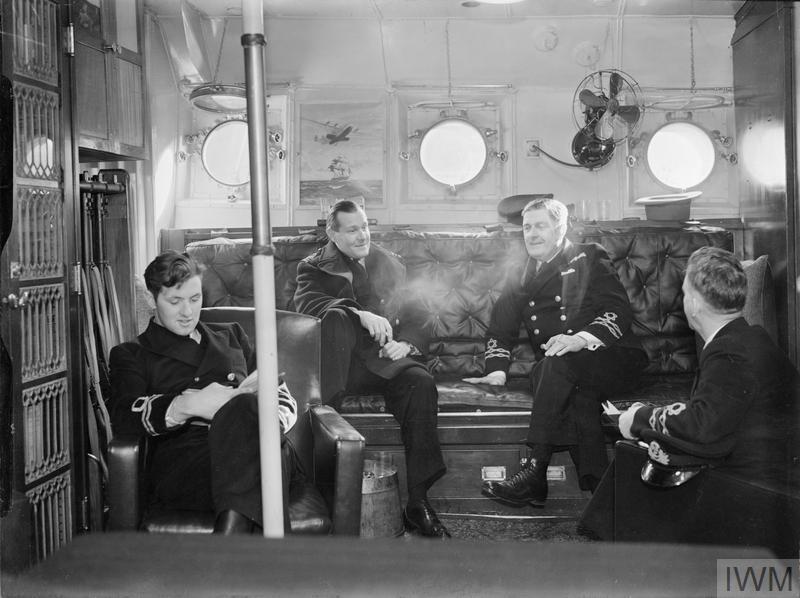
HMCS NIAGARA, In the Wardroom, officers enjoy a quiet spell while awaiting orders to put to sea. Copyright: © IWM. Original Source: http://www.iwm.org.uk/collections/item/object/205137698
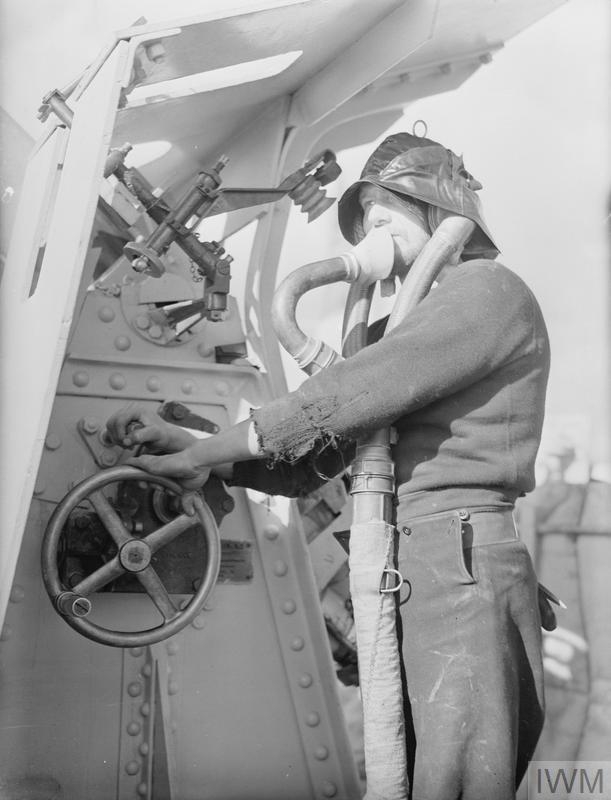
HMCS NIAGARA The gun sight setter with his voice tube awaits orders. Copyright: © IWM. Original Source: http://www.iwm.org.uk/collections/item/object/205137692
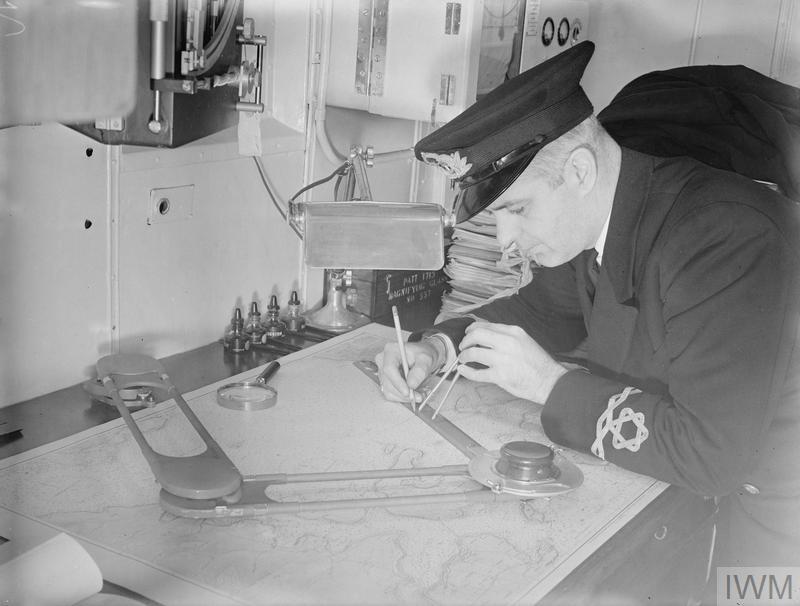
HMCS NIAGARA The Mate, (a rank not used in the British Navy) Sub Lieutenant G H Doty, who until he joined the Canadian Navy was a newsreel cameraman, works out the course on the chart. Copyright: © IWM. Original Source: http://www.iwm.org.uk/collections/item/object/205137705
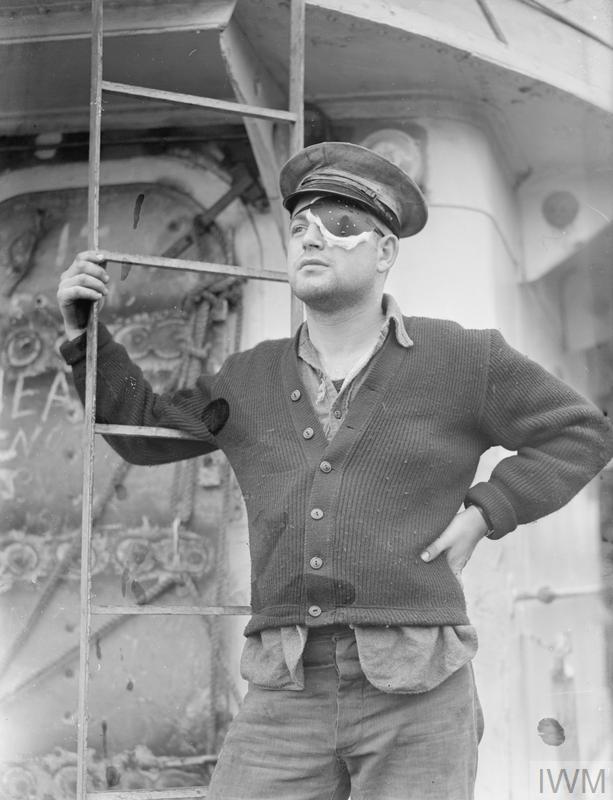
HMCS NIAGARA Petty Officer Ben Pearse was a lumberjack on Vancouver Island. The eye cover is the result of a slight accident. Copyright: © IWM. Original Source: http://www.iwm.org.uk/collections/item/object/205137685
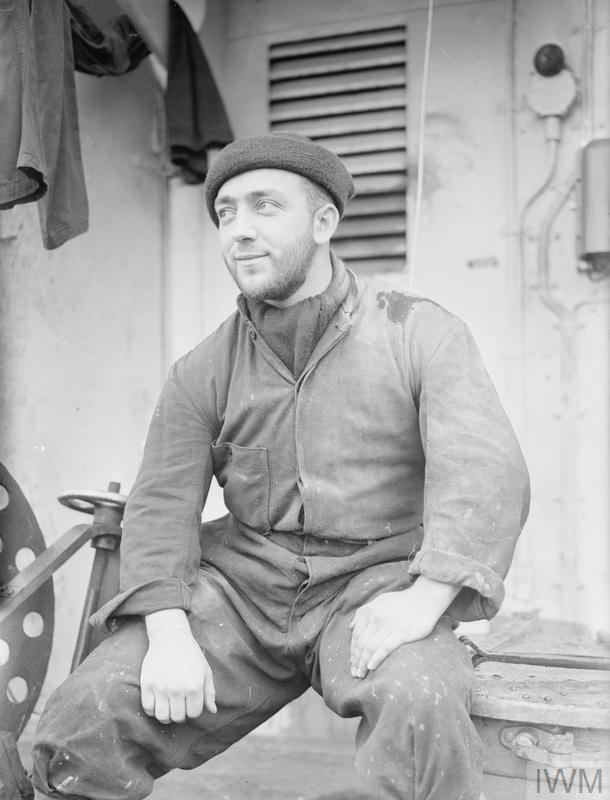
HMCS NIAGARA Gordon Charlebois, French Canadian, of Alexandria, Ontario, who before joining the NIAGARA had never been on board a ship. Copyright: © IWM. Original Source: http://www.iwm.org.uk/collections/item/object/205137687
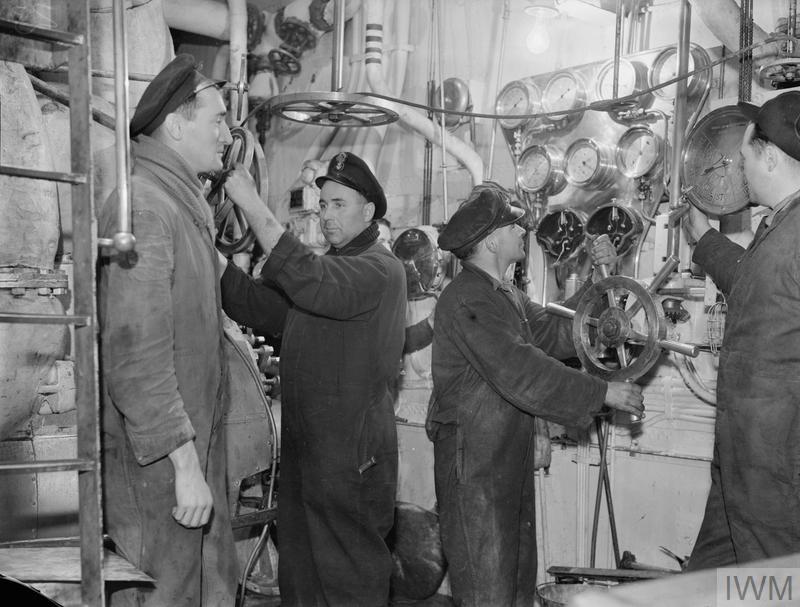
HMCS NIAGARA, Down in the engine room, the Telegraph rings ‘half speed ahead’. Copyright: © IWM. Original Source: http://www.iwm.org.uk/collections/item/object/205137707
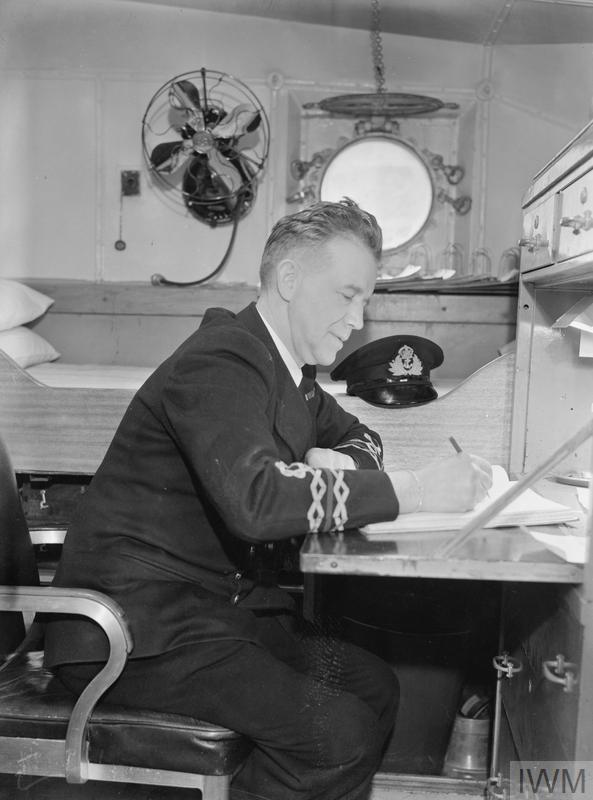
HMCS NIAGARA In his cabin the Engineer Officer, Lieut E Surtees, enters up details of the work done by his staff. Copyright: © IWM. Original Source: http://www.iwm.org.uk/collections/item/object/205137702
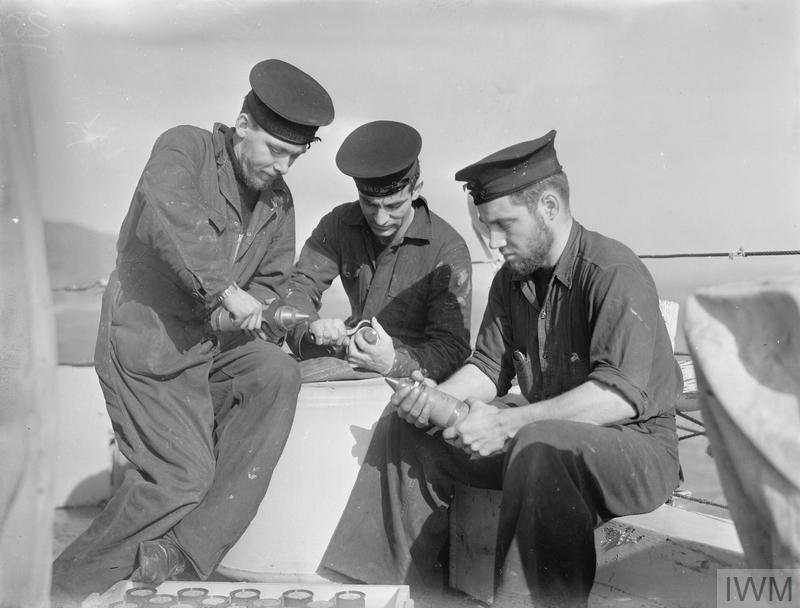
HMCS NIAGARA Members of the crew fix the fuse caps to projectiles for the ‘Twelve Pounder’ gun. Copyright: © IWM. Original Source: http://www.iwm.org.uk/collections/item/object/205137690
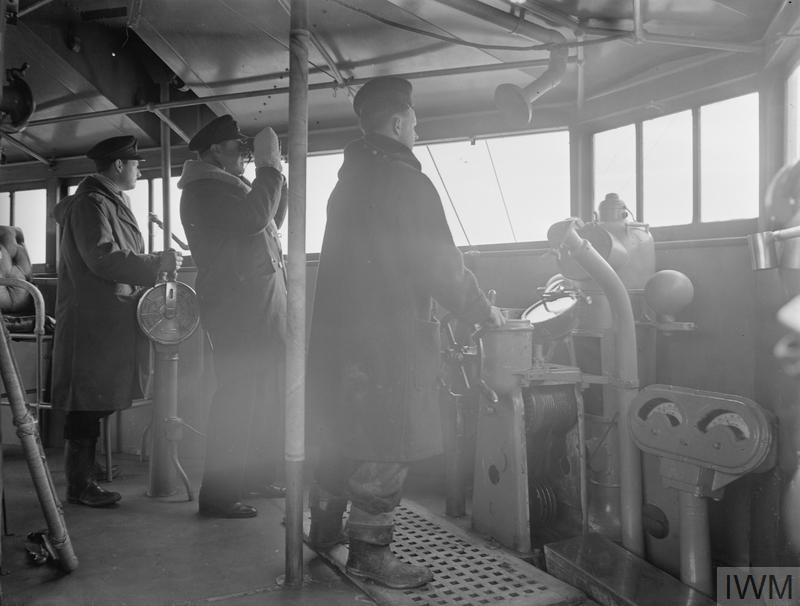
HMCS NIAGARA On the Bridge, the Captain prepares to take the ship to sea. Copyright: © IWM. Original Source: http://www.iwm.org.uk/collections/item/object/205137706
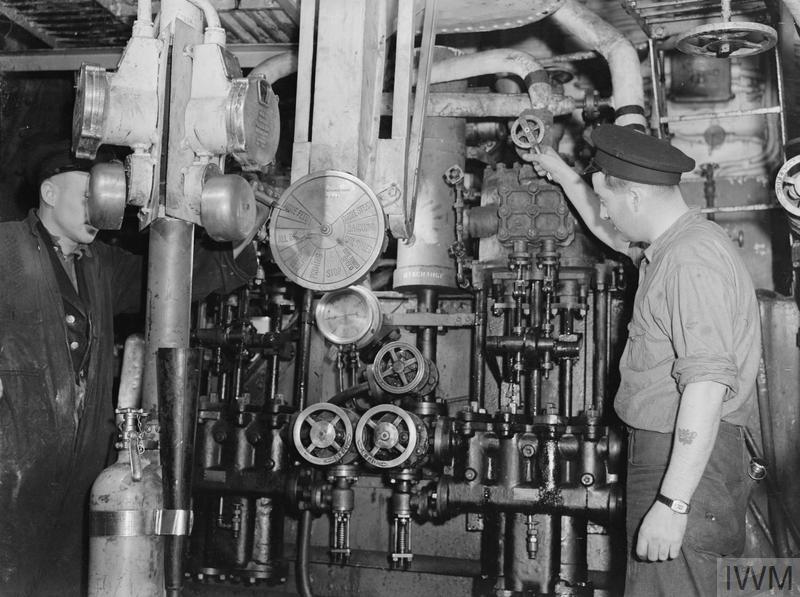
HMCS NIAGARA The boiler room receives instructions on the boiler room telegraph. Copyright: © IWM. Original Source: http://www.iwm.org.uk/collections/item/object/205137708
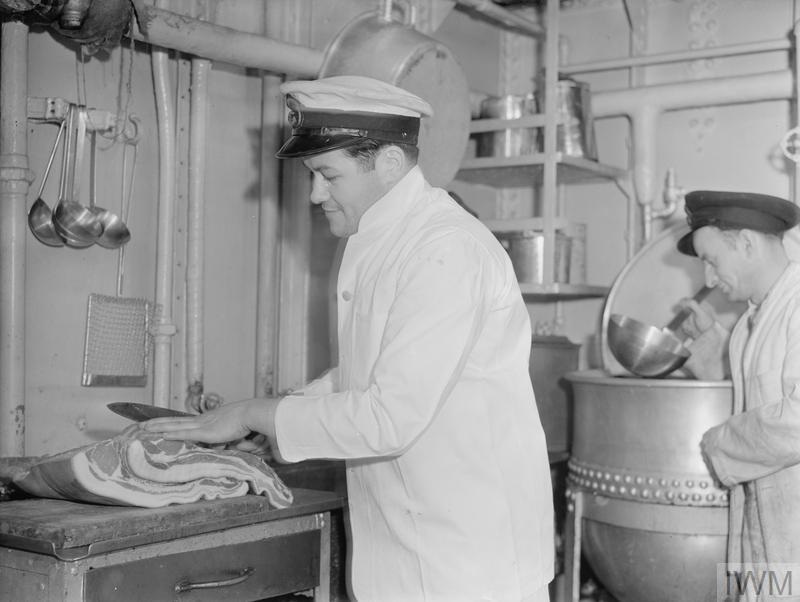
HMCS NIAGARA In the Galley the cook prepares for the next meal, going to sea makes no difference to his routine. Copyright: © IWM. Original Source: http://www.iwm.org.uk/collections/item/object/205137697
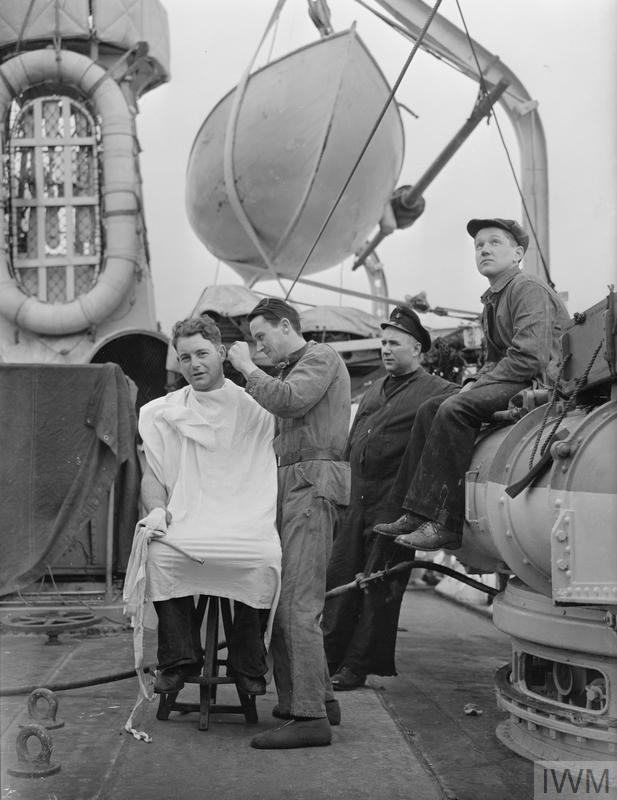
HMCS NIAGARA A member of the ship’s company having a haircut on deck by the ship’s barber. Copyright: © IWM. Original Source: http://www.iwm.org.uk/collections/item/object/205137699
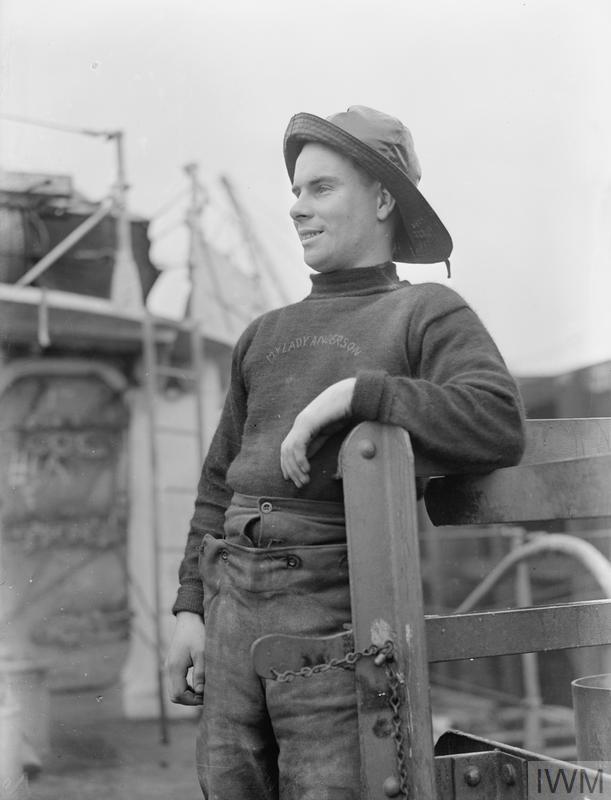
HMCS NIAGARA Jack Lawrence, age 21, of Newfoundland, had served in yachts and merchant ships. Copyright: © IWM. Original Source: http://www.iwm.org.uk/collections/item/object/205137684
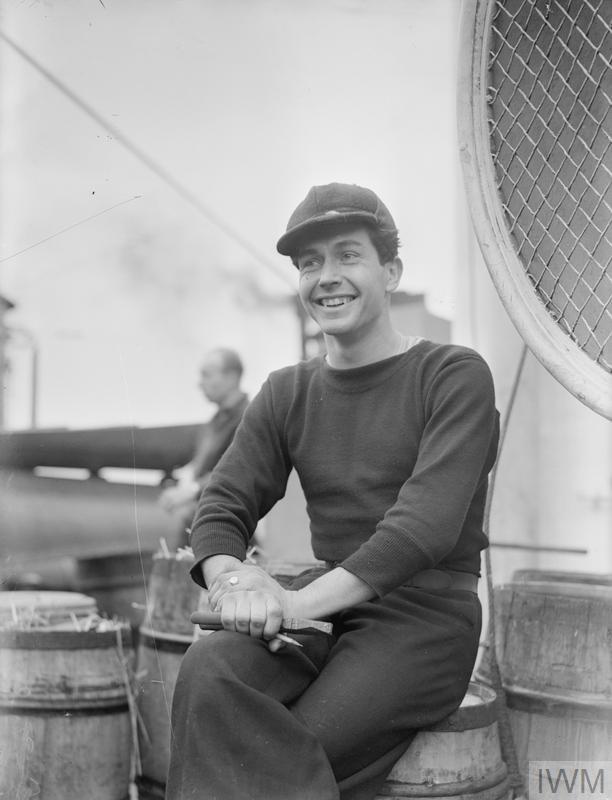
HMCS NIAGARA Lou Kiggins was a drugstore assistant on Prince Edward Island. Copyright: © IWM. Original Source: http://www.iwm.org.uk/collections/item/object/205137688
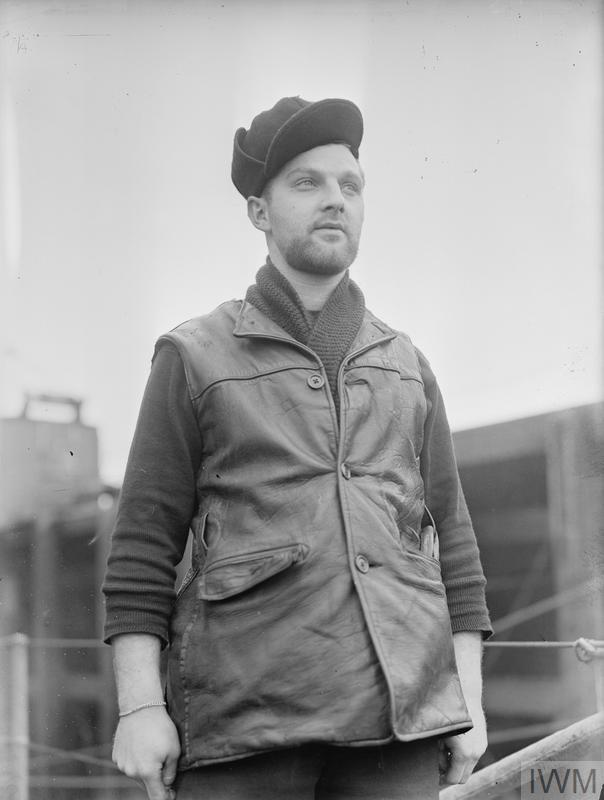
HMCS NIAGARA Leading Seaman Les Porter, who was the Mate of a Lake Steamer. Copyright: © IWM. Original Source: http://www.iwm.org.uk/collections/item/object/205137686
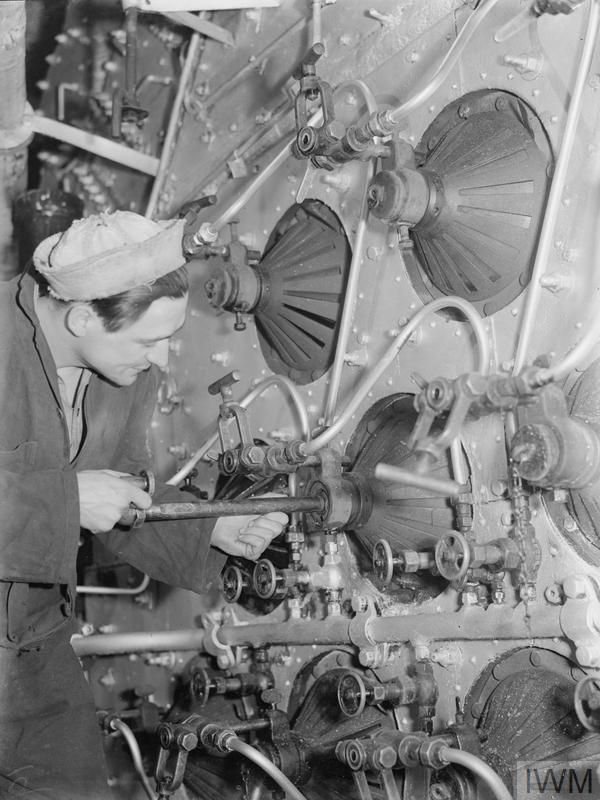
HMCS NIAGARA Replacing the oil fuel jets after ensuring the efficiency of these important sections of the motive power. Copyright: © IWM. Original Source: http://www.iwm.org.uk/collections/item/object/205137703
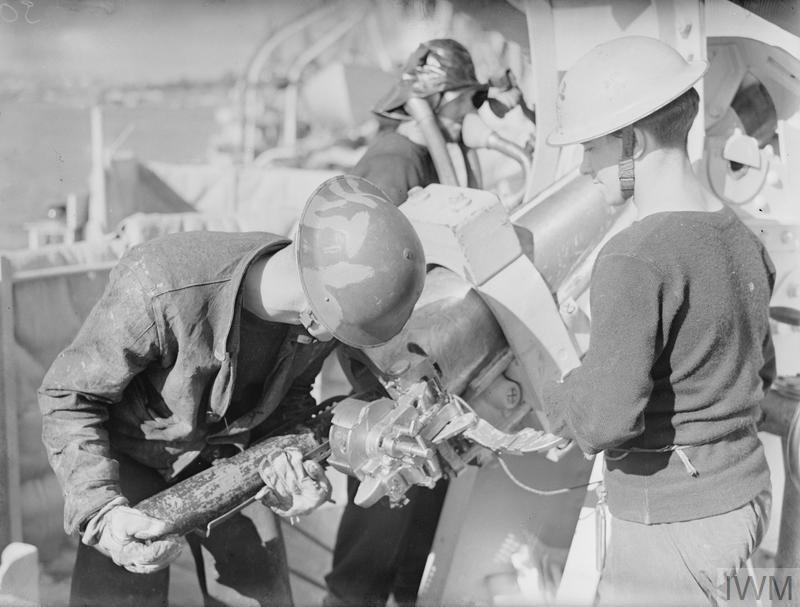
HMCS NIAGARA Action Stations, loading the ‘Twelve Pounder’. Copyright: © IWM. Original Source: http://www.iwm.org.uk/collections/item/object/205137691
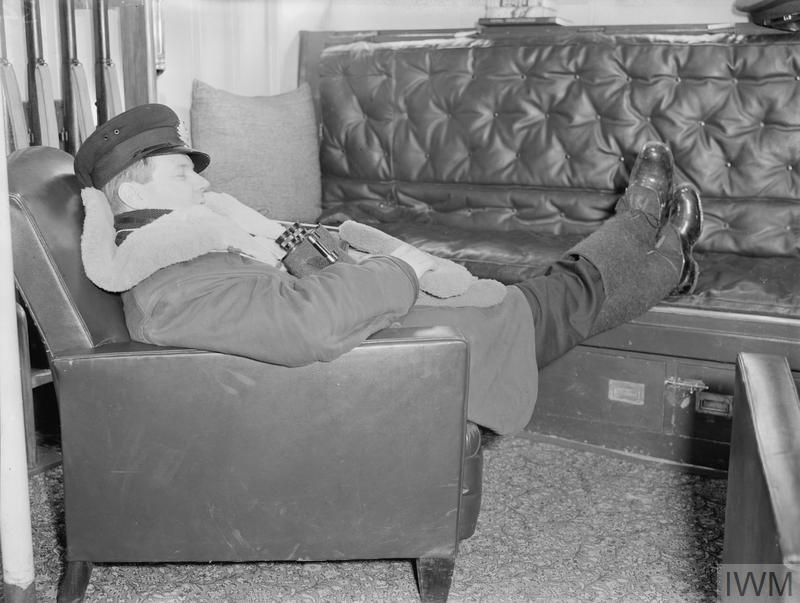
HMCS NIAGARA When at sea the Captain can only leave the bridge for brief snatches of sleep. Here is the Commanding Officer of HMCS NIAGARA having a well-earned nap, but fully clothed ready for instant summons from the bridge. Copyright: © IWM. Original Source: http://www.iwm.org.uk/collections/item/object/205137693
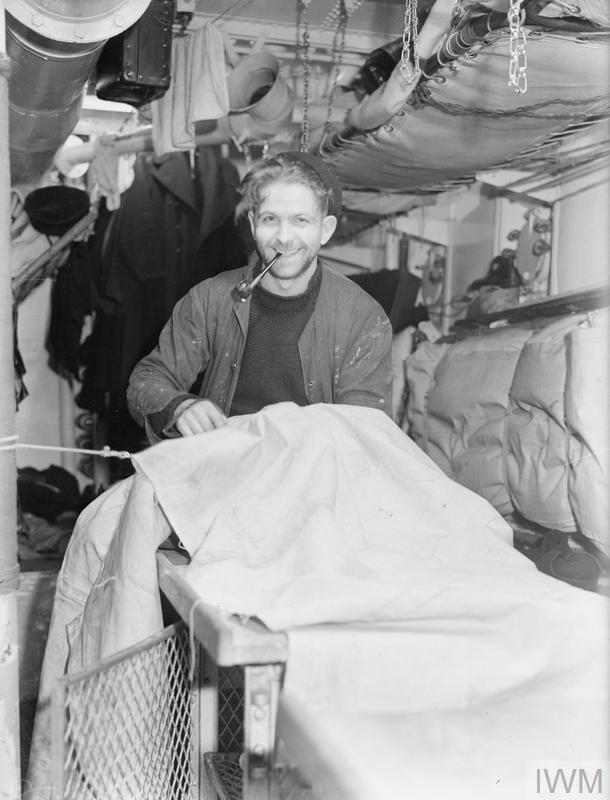
HMCS NIAGARA Tom Williamson was a cable maker at Niagara Falls. Now he is the ship’s rigger in HMCS NIAGARA. Copyright: © IWM. Original Source: http://www.iwm.org.uk/collections/item/object/205137689
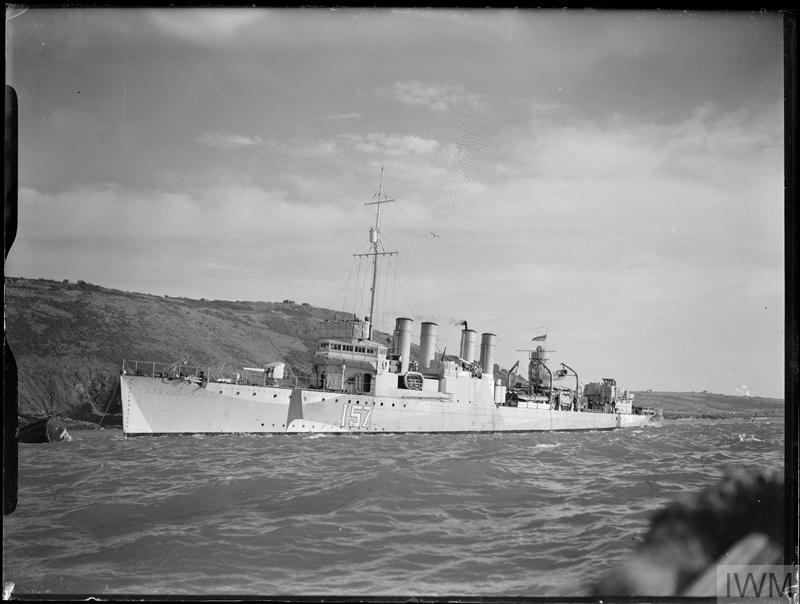
HMCS NIAGARA HMCS NIAGARA. Copyright: © IWM. Original Source: http://www.iwm.org.uk/collections/item/object/205137696
U-570
Niagara’s most famous exploit was in the capture of U-570, a low-mileage German Type VIIC boat operating out of Trondheim, in August 1941.
After being damaged by depth charges from a British Hudson aircraft (269 Sqn RAF/S) in the North Atlantic south of Iceland and surfacing showing a white bed sheet on her tower, Niagara and the destroyer HMS Burwell (H 94)— another destroyer for bases vessel, formerly the Clemson-class four-piper USS Laub (DD-263)— together with a quartet of armed trawlers– HMT Kingston Agate, Northern Chief, Westwater and Windermere— were dispatched to the scene, arriving the next morning.

U-570, its German crew on the conning tower; evident to the left of the conning tower is the white sheet used to surrender to the RAF Lockheed Hudson of No. 269 Squadron.
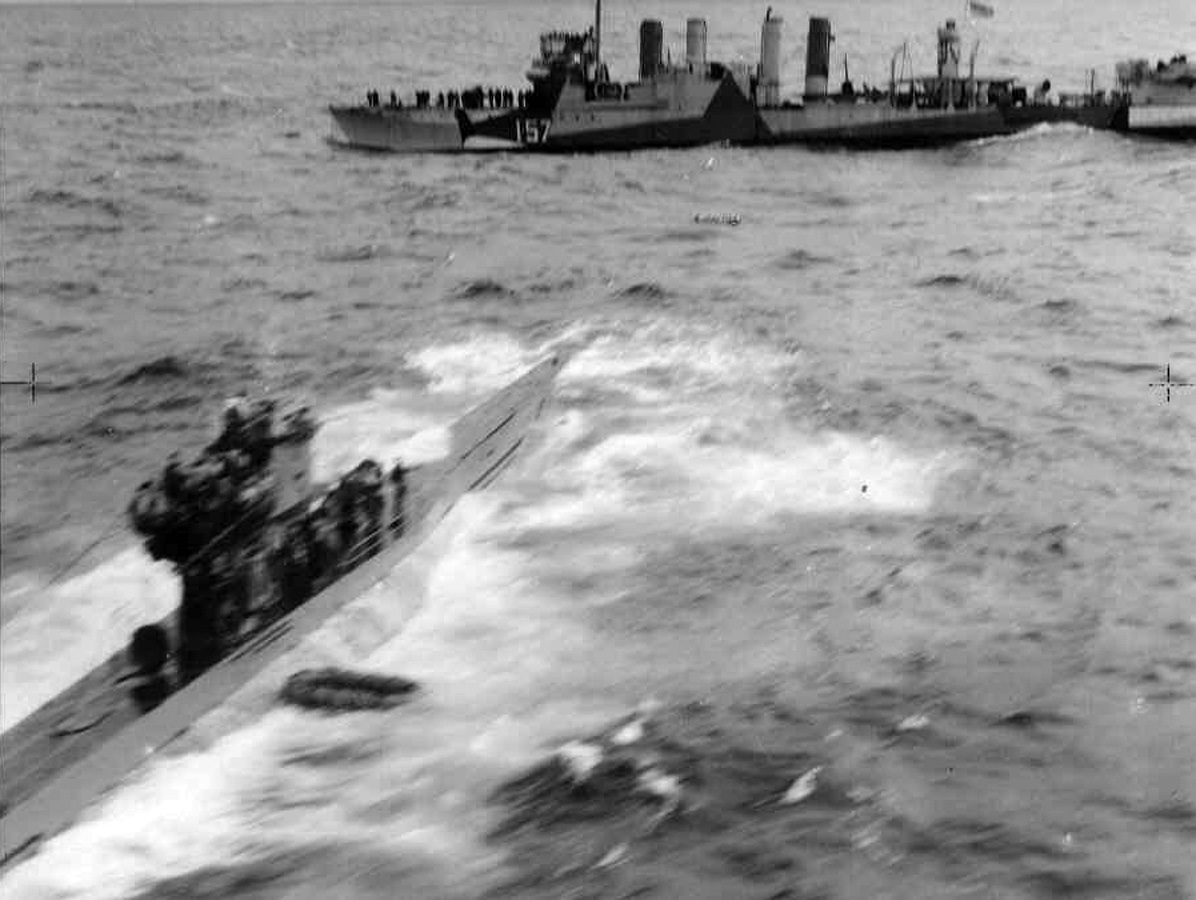
A camouflaged Niagara stands by as a Royal Navy boarding party of four armed men from the HMS Kingston Agate has taken the U-570 under control, their Carley Float (rubber raft) can be seen tied alongside; photo taken from an Iceland-based PBY Catalina during a low pass — Morning, August 28, 1941.
Taking off 43 Germans under the bizarre Kptlt. Hans-Joachim Rahmlow, just seven days into his first war patrol, then installing a prize crew aboard, the trawlers took turns towing the damaged U-boat to Thorlakshafn, Iceland where she was beached, and very thoroughly inspected, detailed plans of her forwarded across all Allied channels.
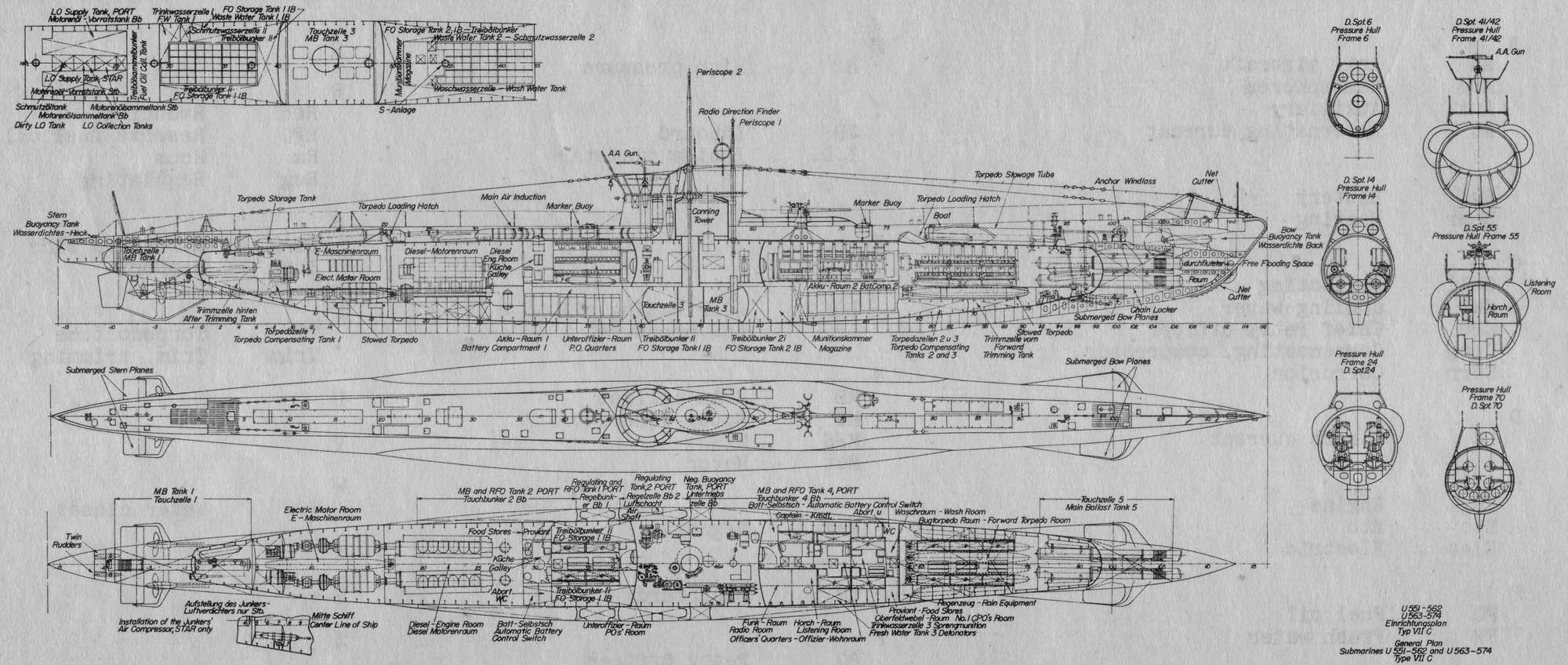
General Plan of the U-570, U.S. Navy ONI Report Enclosure of the redrawn and translated plan of the submarine captured on board — prepared by the David W. Taylor, Model Basin, U.S. Navy (1941).
While Rahmlow had managed to jettison the boat’s the boat’s Enigma machine and codebooks, an officer from HMS Burwell retrieved documents with plain language and enciphered messages which helped the British to read Enigma messages.
Further, the boat was in fine shape with British inspectors noting, “Internally the damage was negligible and consisted mostly of a few broken gauges, gauge glasses, and light fittings probably caused by the depth charges and also by ignorantly conceived attempts to destroy various fittings.” Her motors, engines and pumps, compressors, auxiliaries, etc., appeared to be undamaged and battery compartments dry and sound.
The swashbuckling pistol-wearing skipper of Niagara, LT Thomas P (“Two-Gun”) Ryan, OBE, RCN, a Great War minesweeper veteran, one-time mercenary in South America, and a former police inspector in Ireland, conducted the initial interrogations of the captured German POWs, who were relieved to be (in their understanding) headed to a much quieter life in Canada.
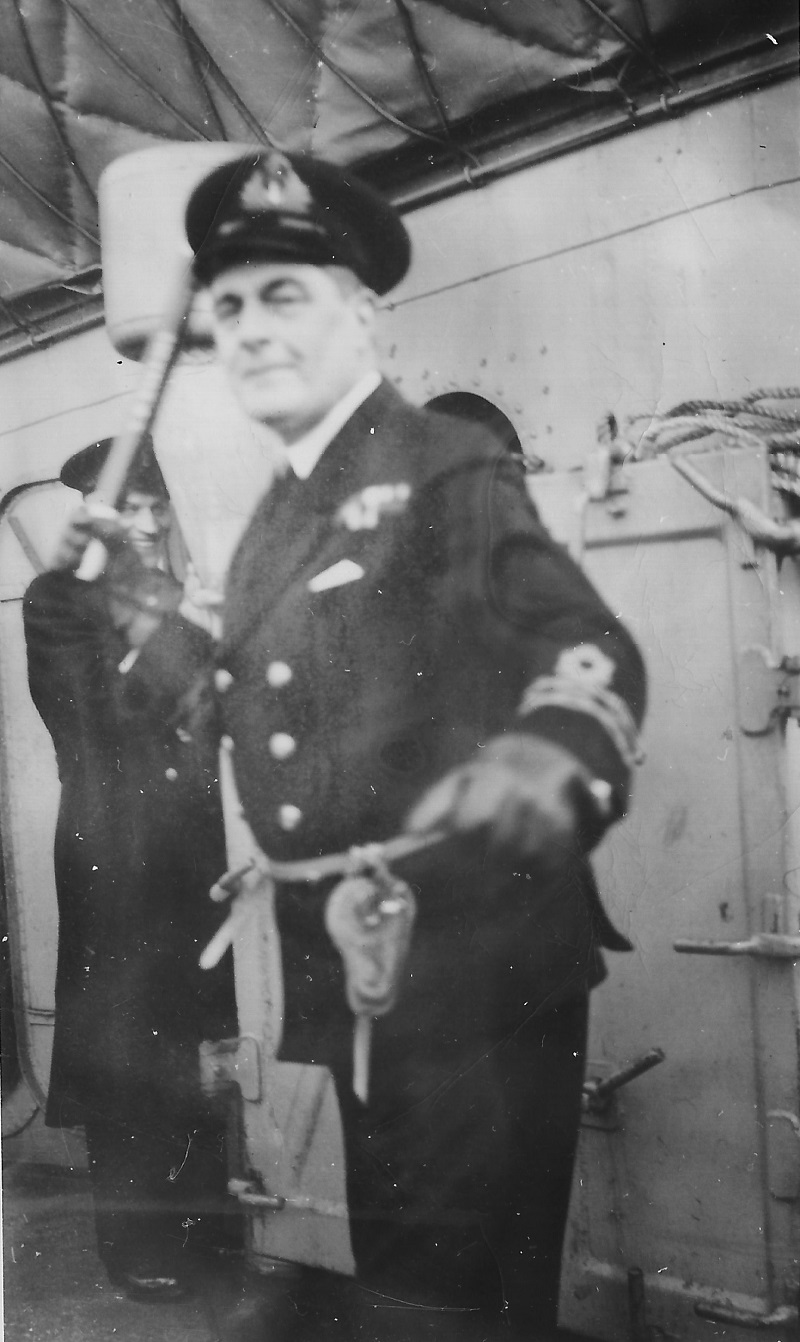
“Two Gun” Ryan aged 51 at the time of U-570’s capture. A recipient of the Bronze Medal in WWI, he later went on to command HMCS Ingonish (J 69), HMCS Dawson (K 104), and HMCS Shediac (K 110) post-Niagara, then shipped out in 1946 to Manilla to distribute Red Cross supplies and write a memoir.
Formal RN interrogators cited U-570’s crews’ shocking lack of experienced hands, noting, “The chief petty officers, and to a lesser extent, some of the petty officers, expressed great concern at the inadequacy of the training and the lack of U-Boat experience, not only of the men but also of the officers and petty officers; no attempt was made to disguise the incompetence of the crew and the officers were severely criticized by all the men.”
U-570 became the British submarine HMS Graph on 5 October 1941 and, as the first operational German U-boat under Allied control– the more famous Type IXC U-505 wasn’t captured by the U.S. Navy until June 1944 — was key to understanding the tactics that would go on to win the Battle of the Atlantic.

German U-Boat U-570 entering the dock at Barrow-in-Furness after her capture by the Royal Navy. IWM Photo, FL 951
Importantly, the U-570/Graph was the only U-boat to see active service with both sides during the war, sent back out for her first Royal Navy war patrol on 8 October 1942.
Back to the war…
Niagara served and served hard, the unforgiving life of a tiny and aging greyhound in the North Atlantic. Suffering from structural weakness and with her boilers worn out, coupled with the fact that other, more modern escort ships were joining the fleet and needed crews, by March 1944 she was pulled from frontline service.
She continued to serve as Torpedo Branch training ship at Halifax throughout 1944 and, shifting to St. John, New Brunswick the following year, would endure in this important service.
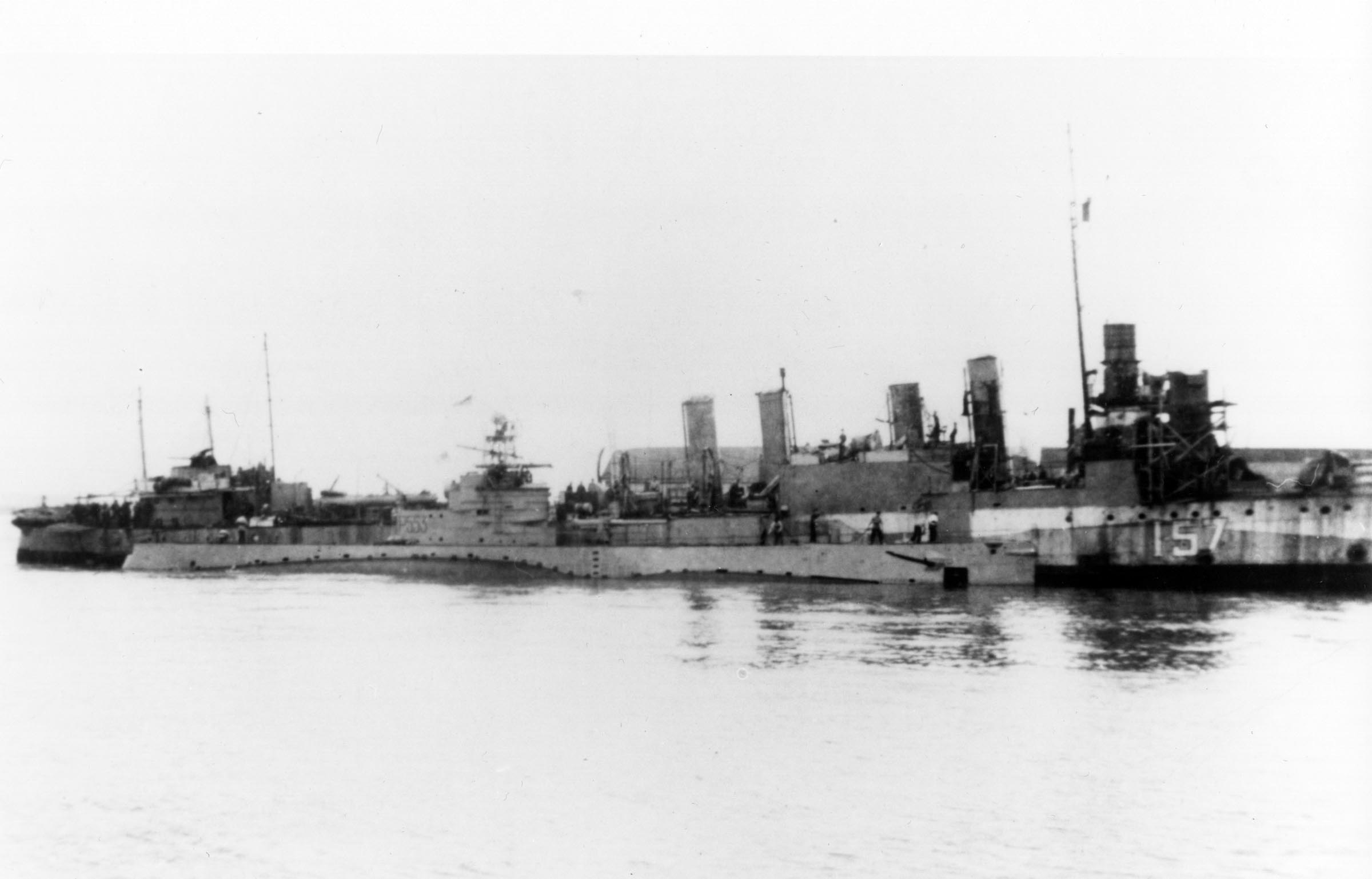
Niagara with the British Royal Navy Submarine HMS P553 (former USS S-21) alongside. This image was taken at Halifax circa 1943-44 as P553, transferred to the Royal Navy at New London on 14 September 1942, was then based at Halifax as an anti-submarine warfare training boat until returned to the USN at Philadelphia on 11 July 1944 and sunk as a target.
Paid off and placed on the Disposal List on 15 September 1945, Niagara was sold to International Iron and Steel for demolition on 27 May 1946 then taken in tow to Hamilton where she arrived at the Breaker’s Yard on 12 December 1947.
Epilogue
The old HMCS Niagara is well remembered by the Royal Canadian Navy Historical Project, For Posterity’s Sake.
Her wartime replacement bell (the original USS Thatcher bell was retained by the U.S. Navy, disposition unknown) has for some time been in the Niagara Falls Museum.
As for the U.S. Navy, a second USS Thatcher, a Fletcher-class destroyer (DD-514), was built at Bath in Maine– just miles from where RADM Thatcher was born– and commissioned on 10 February 1943. She was rushed to the Pacific– helping to sink the Japanese destroyer Hatsukaze during the Battle of Empress Augusta Bay in November 1943– and earned 12 battle stars for World War II service.
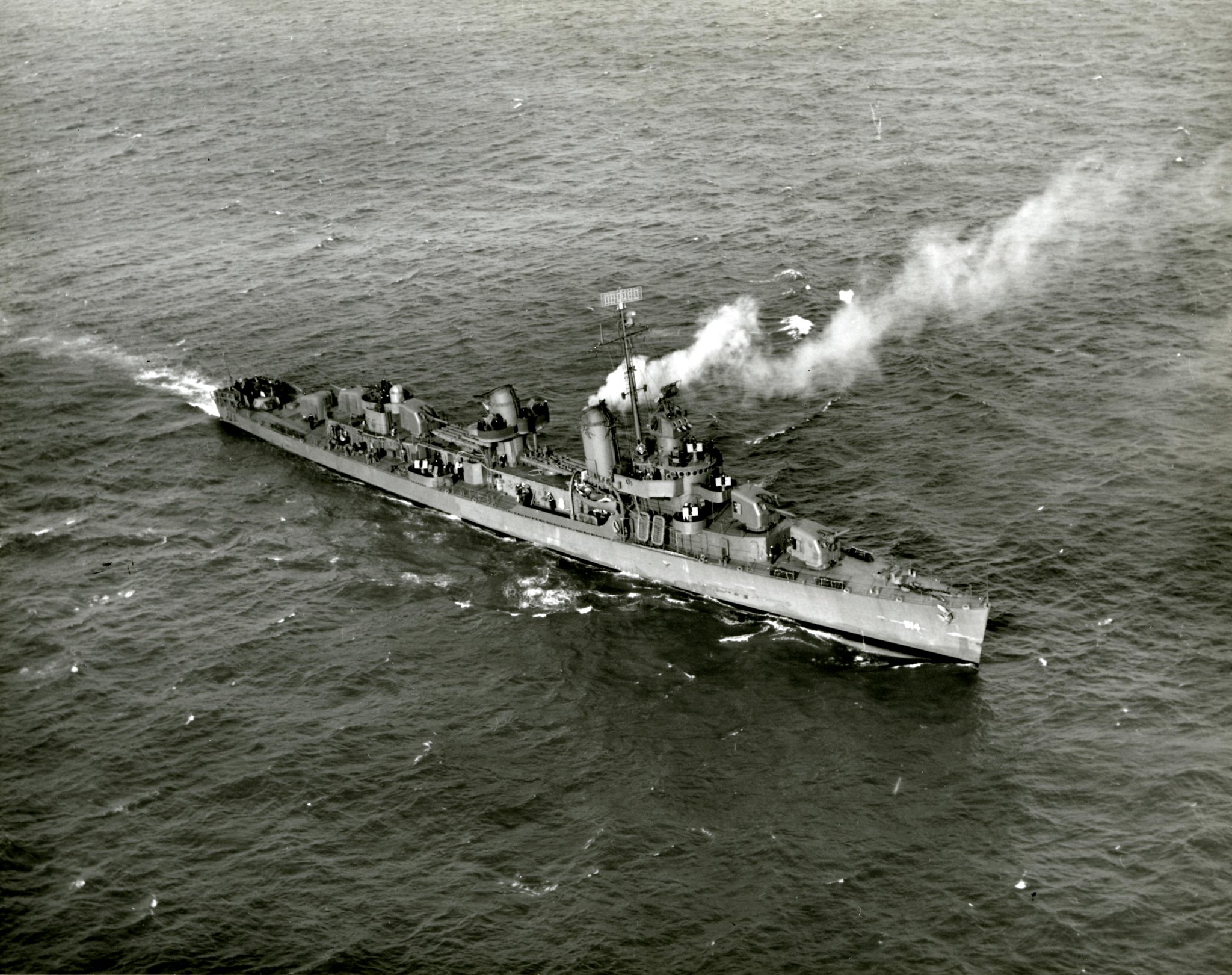
The newly commissioned USS Thatcher (DD 514) in Boston Harbor, Massachusetts, on 28 February 1943. Note 20mm guns amidships and forward using the photographing aircraft as an opportunity for tracking practice. Worn out from her WWII service which included surviving two kamikaze hits off Okinawa, a post-war survey board decided that the ship should be scrapped, and she was decommissioned on 23 November 1945 and then sold for scrap. National Archives photograph, 80-G-36537
There has not been a third USS Thatcher.
As for the name HMCS Niagara, the Royal Canadian Navy’s liaison base as part of the Canadian Embassy in Washington D.C. was known as the shore establishment HMCS Niagara from 1951 to 1965.
Ships are more than steel
and wood
And heart of burning coal,
For those who sail upon
them know
That some ships have a
soul.
If you liked this column, please consider joining the International Naval Research Organization (INRO), Publishers of Warship International
They are possibly one of the best sources of naval study, images, and fellowship you can find. http://www.warship.org/membership.htm
The International Naval Research Organization is a non-profit corporation dedicated to the encouragement of the study of naval vessels and their histories, principally in the era of iron and steel warships (about 1860 to date). Its purpose is to provide information and a means of contact for those interested in warships.
With more than 50 years of scholarship, Warship International, the written tome of the INRO has published hundreds of articles, most of which are unique in their sweep and subject.
PRINT still has its place. If you LOVE warships, you should belong.
I’m a member, so should you be!
